Our RTW trip began under the best auspices when we landed in the frenzy of Beijing. But after a few days of visiting the Chinese capital, we quickly began to feel somewhat overwhelmed by all the surrounding hustle and bustle. So, a little getaway of a few days to the mythical Great Wall and away from the pollution was welcome. Our stay was memorable! Here’s a small summary of the highlights as well as practical information for visiting the Great Wall of China!
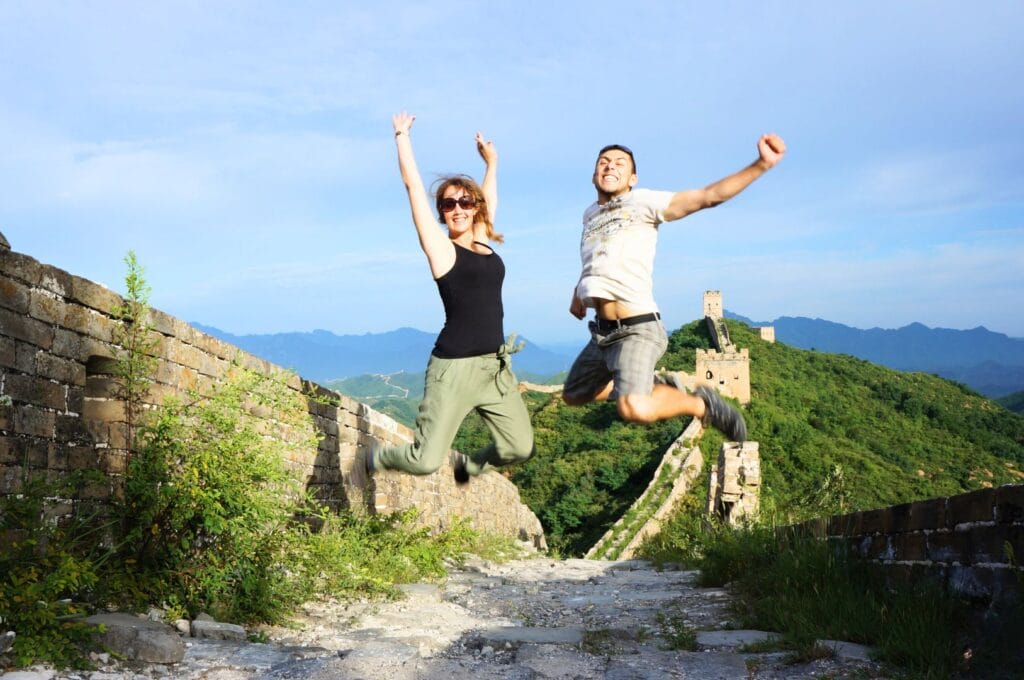
We visited the Great Wall of China in 2014, but the article has been completely revised and updated in April 2025. If you notice any price changes or have additional information that might be relevant, please don’t hesitate to leave us a comment!
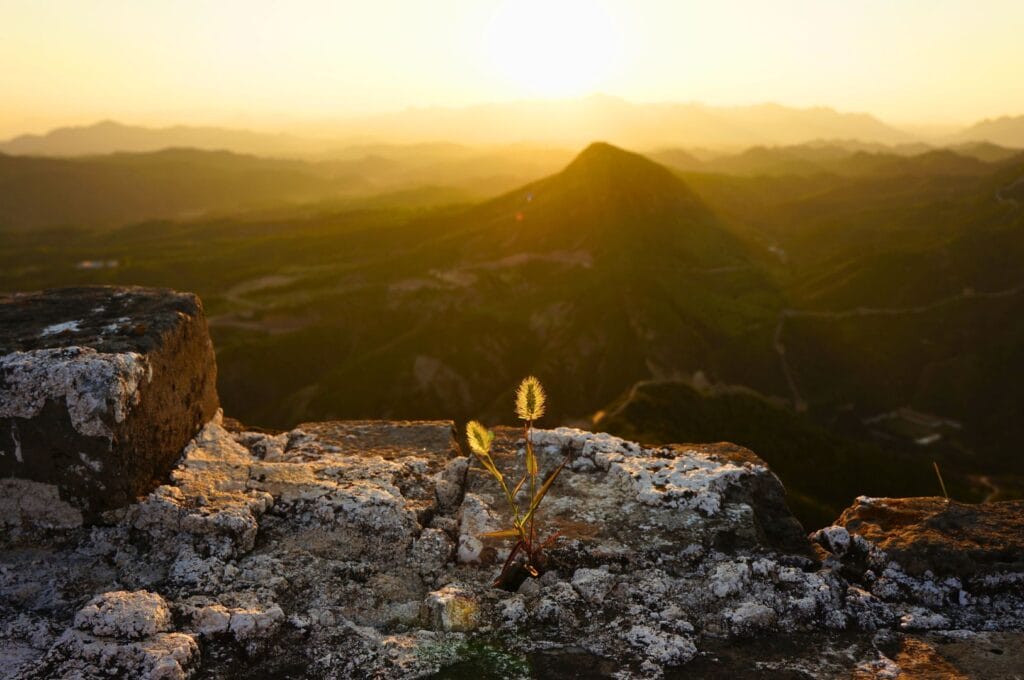
Introduction to the Great Wall of China
How could we not begin this article by telling you a bit more about this giant of human construction? In fact, the Great Wall is definitely the largest human creation in terms of size, volume, and everything else you can think of! The first time we caught a glimpse of it, an incredible feeling overwhelmed us—it was just wow! It’s easy to understand why it has been listed as a UNESCO World Heritage Site since 1987 and is one of the 7 new wonders of the world!
In a few numbers
This stone giant starts from north of Beijing and extends to the Gobi Desert! As for its length, opinions vary quite a bit, as some sections are destroyed or buried underground. The most frequently cited estimated total length is 6700 km of fortifications! At the same time, I want to tell you that given the distance it represents, we’re not quibbling over 3 km here or there, right? Otherwise, in terms of width, this stone and earth colossus measures on average 4-5 m wide and 7-17 m high!
However, sorry to disappoint some of you, but you cannot see the Great Wall from space! It’s a legend, but that doesn’t take away from its charm ;).
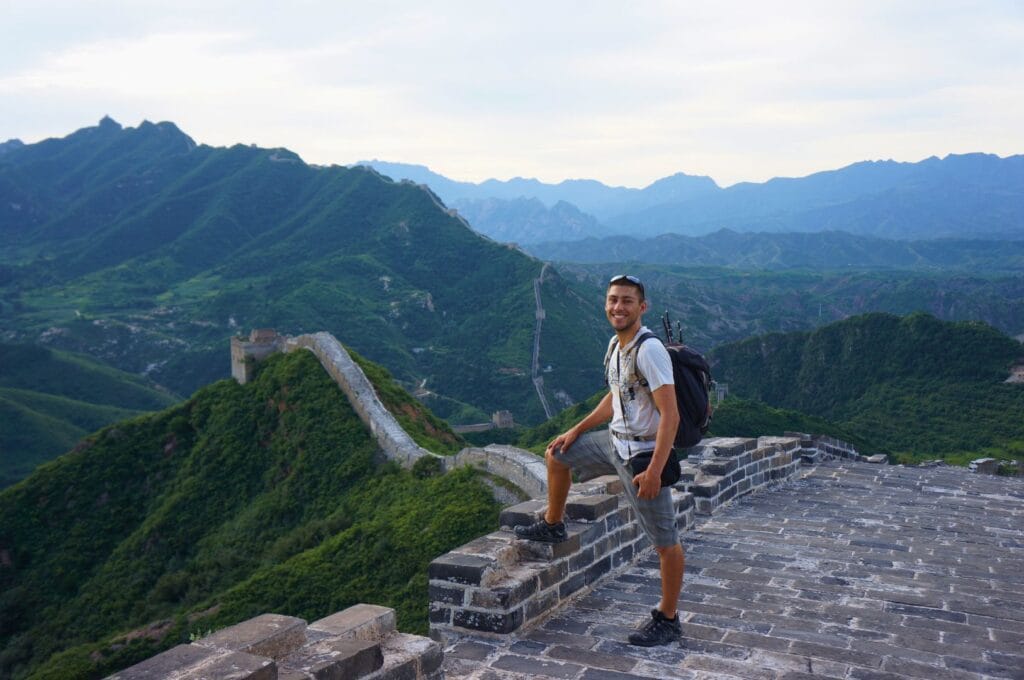

History
The Great Wall of China was built in several stages between the 3rd century BC and the 17th century to defend the northern border of the Middle Kingdom. In itself, a wall doesn’t protect that much… That’s why, all along the wall, there are huge watchtowers and bastions where guards were stationed and from which they could communicate with each other. In the end, this immense construction never really repelled any invasion… These days, the greatest threat is probably the invasion of tourists ;)!
Note: Although several dynasties succeeded one another during its construction, the Great Wall of China that we know today is the one built and/or renovated under the Ming dynasty. To learn more about the history of this monument, we recommend this reading.
Where to visit the Great Wall of China?
You can imagine that to visit the Great Wall, there are hundreds of possibilities along its 6700 km length! In short, we have choices. However, it’s not easy to find a place that is both easily accessible while being deserted by mass tourism… To give you an idea, the Great Wall of China welcomes more than 10 million visitors each year!

We detail in this article all the accessible sections of the Wall to organize your itinerary. They are ranked from closest to farthest from Beijing.
Our opinion: You’ll see that each section has its style and environment. We haven’t done them all, but after writing this comprehensive report, if we had to choose just one, it would be a close match between Jinshanling and Simatai. Otherwise, if you have less time or simply don’t want to take public buses, there are, of course, numerous tours that go to the Wall. Here, too, we encourage you to travel a bit further and avoid the sections that are too close to Beijing.
Here are our recommendations based on what you’re looking for when visiting the Great Wall of China:
- off the beaten path and without tourists: Jinshanling, Simatai, Gubeikou, Chenjiapu, Dayingpan, Huanghuacheng, Jiankou, Bailingguan, Huangyaguan
- in half a day: Mutianyu, Badaling, Simatai, Juyongguan, Huanghuacheng, Huangyaguan
- with a day hike: Gubeikou–Jinshanling, Dayingpan
- easy access: Badaling, Mutianyu, Shanhaiguan
- on unrestored sections: Jiankou, Gubeikou, Dayingpan, Bailingguan
- for a sunset: Simatai, Jinshanling, Jiankou
- at night: Simatai, Mutianyu, Juyongguan
- family-friendly or with children: Mutianyu, Badaling, Jinshanling (if children can walk/climb stairs), Simatai, Jiayuguan, Huanghuacheng
Tip: if you’re lost, show Chángchéng 长城 (the Great Wall in Chinese) to any taxi driver ;).
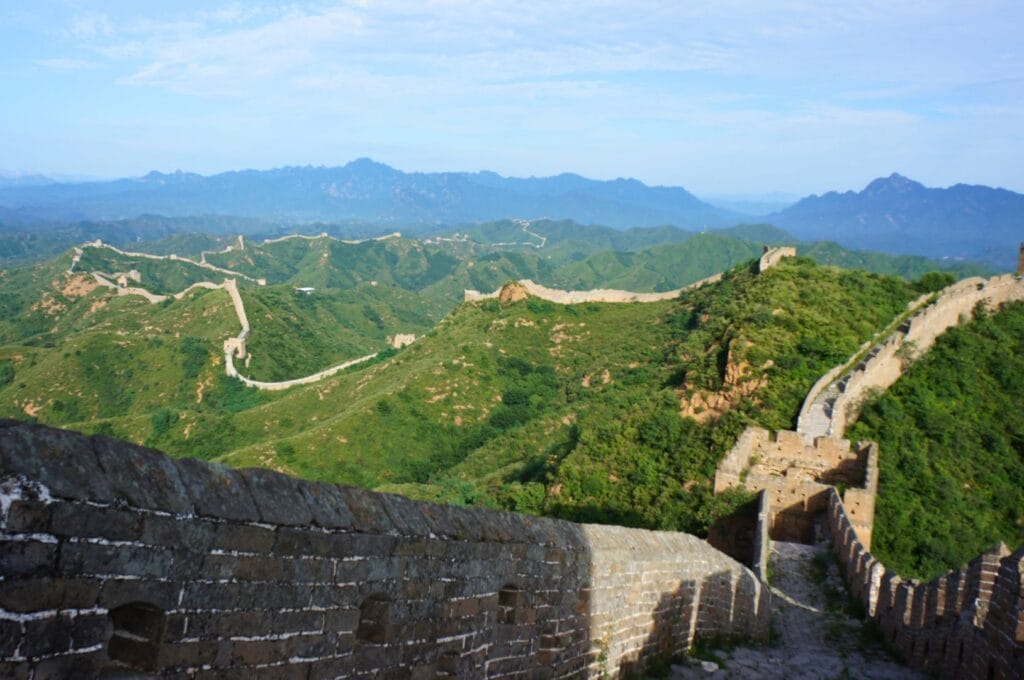

Juyongguan
Introduction to Juyongguan
Juyongguan is the closest section to Beijing! Yet, tourists don’t flock to this portion of the Great Wall of China as much as they do to Badaling. Only 60 km need to be traveled from the Chinese capital. The particularity of Juyongguan is that the fortifications pass through the Juyongguan pass for a panoramic view of the Wall winding through the Guangou valley. Due to its geographical location, this portion was equipped with a military fortress to have a strategic role against Mongol invasions.
Honestly, we would recommend Juyongguan over Badaling: it’s less crowded, and the landscapes are more picturesque.
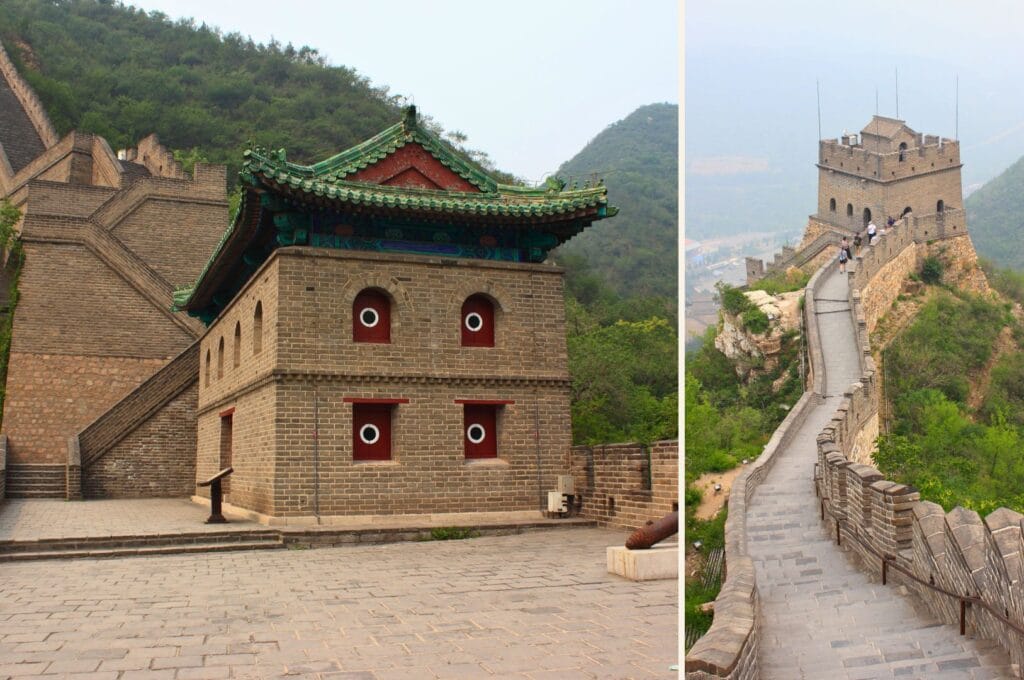
In short, Juyongguan is:
- a 4 km portion of the Great Wall of China dating from the Ming dynasty (between the 14th and 17th centuries) and restored in 1992
- a marble cloud platform dating from the 14th century (Yuan dynasty) with Buddhist architectural details
- 14 watchtowers in hilly landscapes (500 meters of elevation gain for the total circuit)
- a half-day visit (about 4 hours)
- the possibility of visiting the Great Wall at nightfall
- 60 km to travel from Beijing (1 hour by road)
Map of Juyongguan
Here is the map of the Juyongguan section. You’ll find the walking route to visit the 2 sections.
Visiting Juyongguan
Due to its strategic position, the Great Wall here forms a loop between the east and west sectors and the north and south gates of the fortress. The western part is the most impressive as you’ll dominate the entire Wall and the Guangou valley. We should warn you, you’ll climb many steps and it’s quite steep, especially in the west! If your physical condition is limited, we recommend doing only the eastern part. Also, don’t hesitate to walk around the cloud platform to discover the fort, the different temples, and the dedicated museum.
Practical information
- Opening hours: From 8 a.m. to 5 p.m. (between April 1 and October 31), from 8:30 a.m. to 4:30 p.m.
- How to get to Juyongguan (1 hour from Beijing):
- With a tour: We recommend this tour for its excellent value for money!
- On your own:
- By bus: Although Juyongguan is close to the Chinese capital, it’s not so easy to access by public transport! Several routes are possible, but only bus 919 is direct. It leaves from the Deshengmen bus station and stops at the foot of the Wall at Juyongguan. To get there, get off at the Jishuitan metro station on line 19 (light pink) or line 2 (dark blue). In total, expect to spend 2 hours by bus and a bus ticket around 15 yuan per person.
- By private car: With a Didi, the equivalent of an Uber in China, count about 25-30 dollars for a one-way trip in 1 hour from downtown Beijing (50-60 for round trip). Don’t hesitate to share the vehicle with other travelers! A taxi ride will cost a bit more.
- Staying in Juyongguan: It seems that 2 hotels share this segment of the Wall, but we don’t have more info than that.
- Price: The entrance ticket for Juyongguan varies according to the time of year. The rate is 40 yuan during the tourist season, between April 1 and October 31. In the low season, entry costs 35 yuan. You can buy them on-site or buy them online. For night visits, they take place during the high season, from 6:30 p.m. to 10:30 p.m. and you must buy your tickets on site. Only the first watchtowers are accessible at night, and you will attend shows on the fortifications.
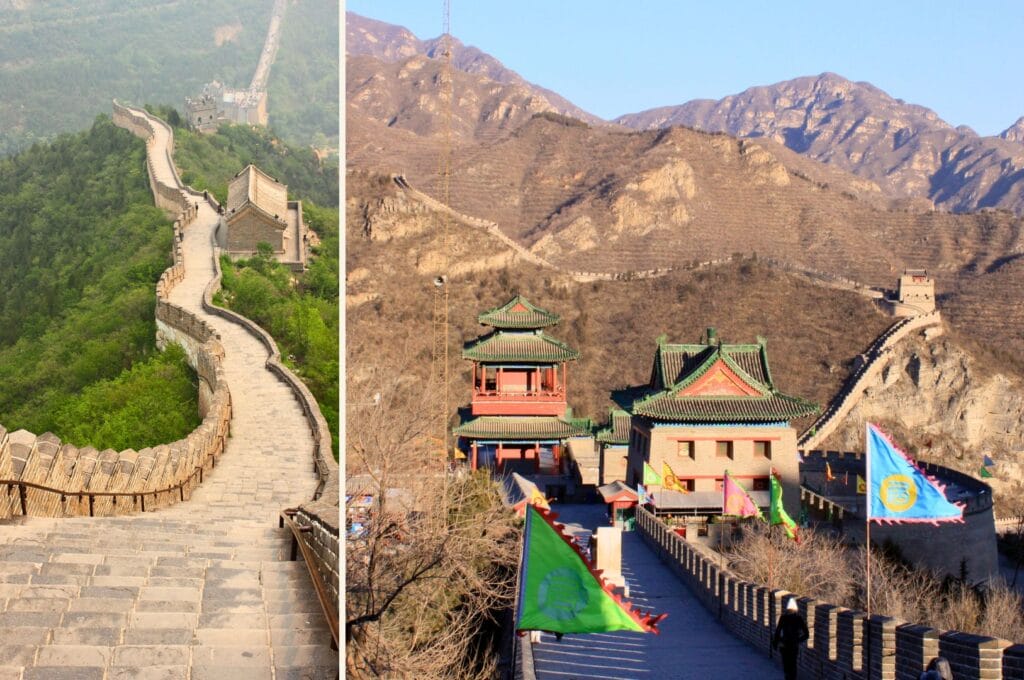
Badaling
Introduction to Badaling
The most famous section of the Great Wall is called Badaling. This fully restored section is located about 80 km north of Beijing, making it a very popular destination for day trips from the capital. However, in Beijing, tourists are not just the few Westerners that we run into here and there in a tourist alley. No, millions of Chinese tourists come from all over the country to discover their capital and its surroundings.
If you decide to go to Badaling, be prepared to face a tide of visitors and to spend your time declining (or not) the proposals of street vendors. Perhaps you’ve already seen photos where the ramparts are black with people?! To tell you the truth, Badaling welcomes an average of more than 55,000 visitors every day. Attendance breaks records during the first week of October during the golden week, the Chinese national holidays. There have been up to 100,000 tourists in one day and that’s just at Badaling! In short, skip this one if you’re agoraphobic ;).
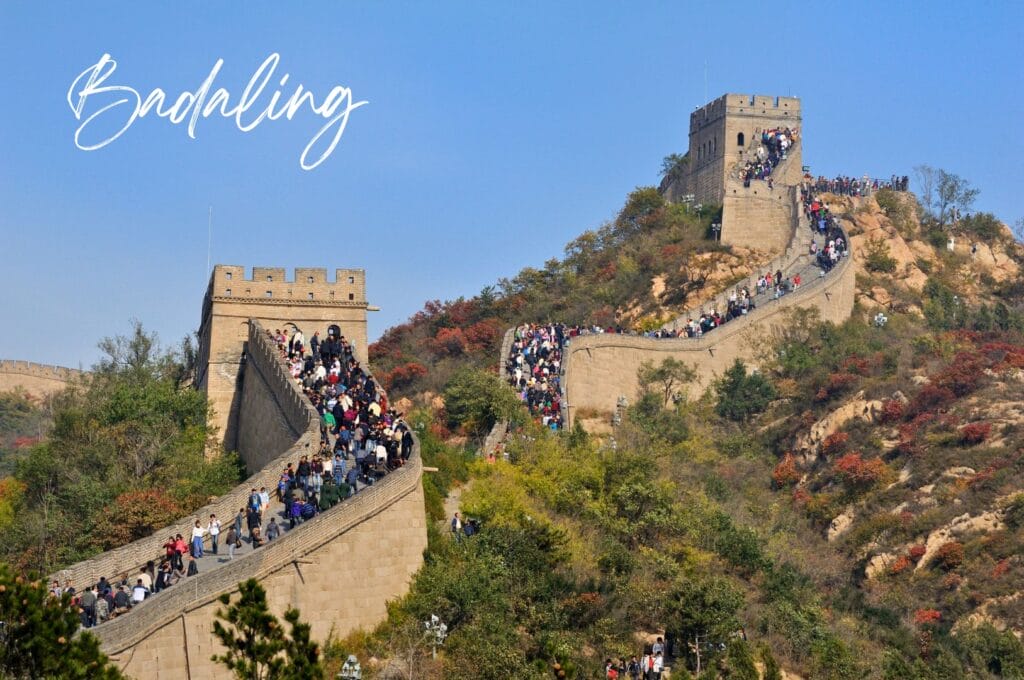
Moreover, due to the frequency of visitors to this section, quite a few infrastructures have been installed: cable cars to access higher areas, permanent exhibition, huge parking lots, animal park… For the wild and natural side, this is not the section we recommend. Here, we’re more in a Disney World atmosphere ;). If you’re traveling with family, are unable to hike, or have a disability, Badaling is however perfectly suitable.
In short, the Badaling Wall is:
- a 3.7 km well-preserved section dating from the Ming dynasty and fully renovated at the end of the 20th century
- 2 cable cars, 1 toboggan
- 19 watchtowers
- 72 km to travel from Beijing (1 hour 30 minutes by road)
- a short half-day visit
- and… lots of people!
Map of Badaling
To better represent this part of the Great Wall of China, here is the map of Badaling with the route if you travel the entire site.
Visiting Badaling
So, we can divide Badaling into 2 north and south parts, connected to each other, each with its own entrance. The total tour is about 8 km long, with less than 500 m of positive elevation gain.
You’ll arrive at the north entrance if you take the train and the south entrance if you come by bus. On the map, we’ve proposed an itinerary from the south entrance that passes through all the notable points of interest of Badaling. The north cable car takes you directly to tower 8 and its southern counterpart arrives between south towers 4 and 5. As the fortifications follow the reliefs, it climbs between the entrance and tower 8 and expect to climb many steps! To get away from the crowd concentrated mainly at tower 8, head towards tower 12 or the south sector.
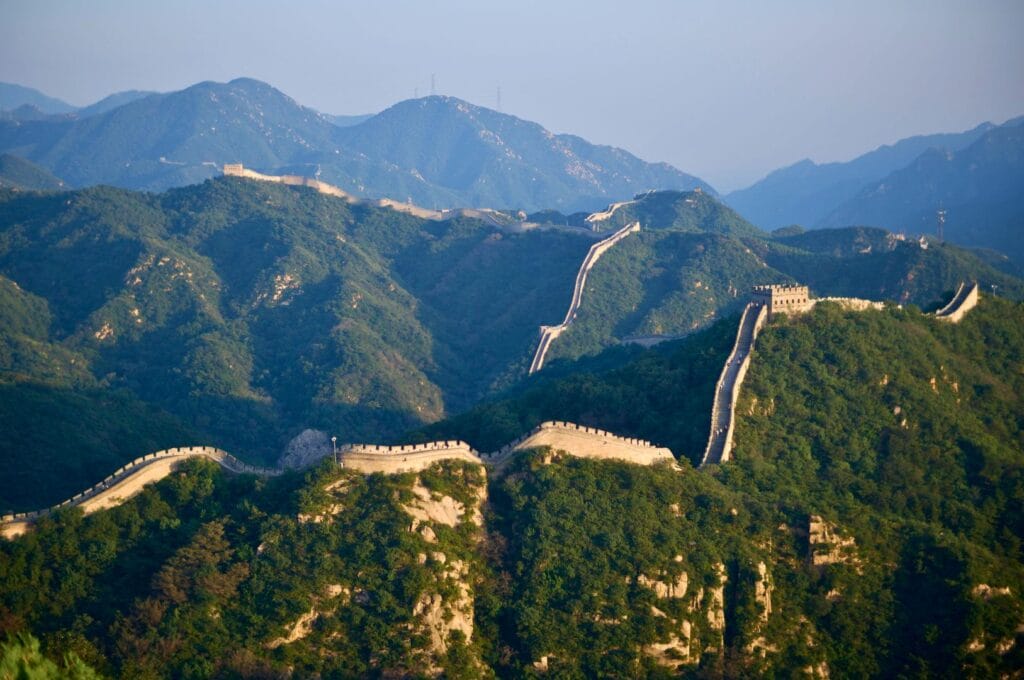
Practical information
- Opening hours: between March 16 and November 15, Badaling is open every day from 7:30 a.m. to 6 p.m. (6:30 p.m. on weekends), and from 8 a.m. to 5:30 p.m. the rest of the year.
- How to get to Badaling:
- With an excursion: You’ll find many tours to get to Badaling. The cheapest is this one (with an English-speaking guide included on the bus). For an all-inclusive formula, we recommend this one, which includes transport and tickets, all with an English-speaking guide.
- On your own: Given its popularity, it’s very easy to get to this section of the Great Wall by public transportation.
- By train: 2 trains reach Badaling, the high-speed one and the suburban one, the S2 train. The high-speed train leaves from Qinghe station in Beijing (line 13, the yellow one, Qinghe Railway Station stop), while the S2 train leaves from Beijing Huangtudian Railway Station (line 8 or 13, the green or yellow, Huoying stop, exit G4). The first takes 20 minutes to reach the Wall station with departures every 20 minutes (tickets about 60 yuan) and the second takes 1 hour 30 minutes (tickets) with departures every 2 hours. The high-speed train stops at the Badaling Great Wall Railway Station and the S2 drops you off at Badaling Railway Station, both less than 1 km from the entrance (it seems there are free shuttles, to be seen on site). As train tickets are always in high demand, we strongly recommend you book your tickets on this site. For the S2, you can use your Yikatong card for the Beijing metro or buy a ticket on site.
- By bus: Only one number to remember: 877, which leaves from the Deshengmen bus station (Jishuitan stop, lines 2 or 19, the light pink and dark blue).
- Staying in Badaling: A few hotel establishments are located in Badaling, but we warn you, it’s more expensive than in the capital!
- Price: The basic Badaling ticket costs 40 yuan. You’ll need to add 140 yuan for the round-trip funicular (100 for one way). You can buy them on-site or get skip-the-line tickets (or transport + ticket via this site).
- For night tours, departures are scheduled at about 4:30 p.m. from May onward. Check the rates here.
This article contains affiliate links to partner sites. When you use our links to book accommodation, a car, or an activity, you don’t pay anything extra, but we get a small commission. This helps us to offer you free, independent, and ad-free content. Thank you for your support!
Chenjiapu
Chenjiapu is a fairly confidential section of the Great Wall, although it’s located not far from Badaling! Information for accessing it is quite rare… Apparently, everything (transport, accommodation…) goes through the guesthouse Great Wall Fresh, but we haven’t been able to contact them. If you have other info, don’t hesitate to share it in the comments :).
Mutianyu
Introduction to Mutianyu
Also renovated, Mutianyu is the second most popular section of the Great Wall of China. This section is easily accessible as it is located 70 km north of Beijing. There are certainly people, but fewer than at Badaling. Here, you’ll explore 20 watchtowers spread over just under 3 km, which is quite unique on the Wall! Its other peculiarity is the possibility of going down by sled, thanks to the huge slide for the enjoyment of young and old alike.
If you can only spend half a day on the Wall, then we would recommend this section. Like Badaling, Mutianyu is perfect if you are with children. Note that Mutianyu is connected to the Jiankou section, but it is theoretically not possible to reach it on foot (presence of a guard).
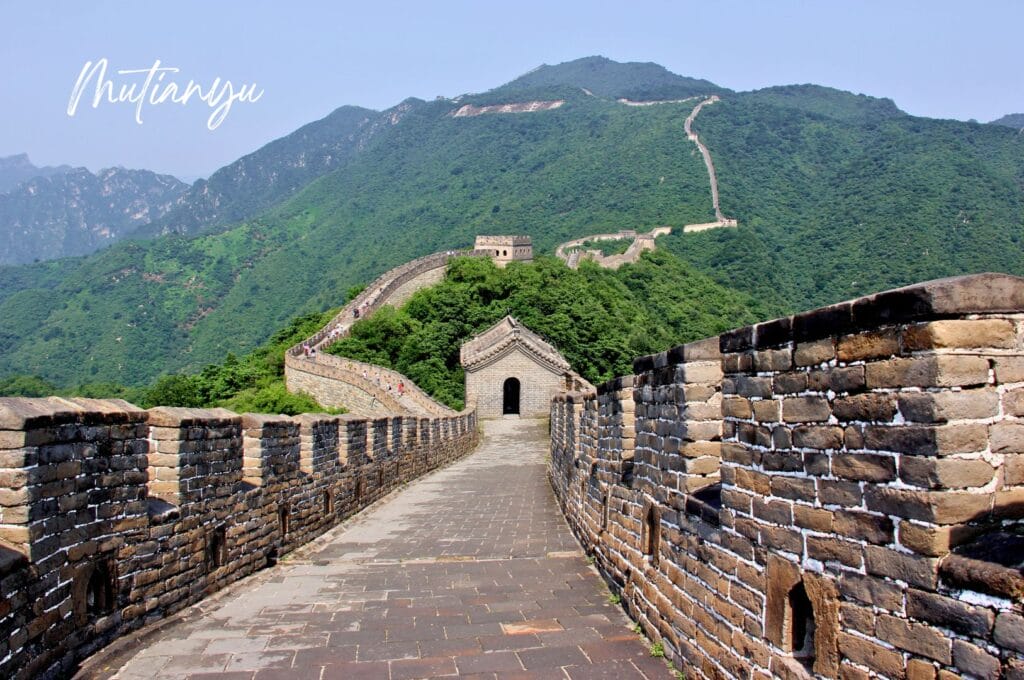
In short, Mutianyu Great Wall is:
- a 2.8 km portion surrounded by forests, dating from the 6th century (Northern Qi dynasty) and restored in 1569
- 20 watchtowers to explore
- 1 cable car, 1 chairlift, 1 giant slide
- the possibility of visiting the Great Wall at night
- a good half-day visit 70 km to travel from Beijing (1 hour 30 minutes by road)
Map of Mutianyu
To help you find your way and visualize the site, here is a map of the Mutianyu Wall with the profile if you do the entirety of this section and climb on foot.
Visiting Mutianyu
Whatever your means of transport, you will likely arrive at the Mutianyu roundabout, where the exhibition on the Wall is located. To reach the beginning of the paths that lead to the Wall and to the 2 north and south entrances, you can walk the 2.5 km that lead to the official entrance or take a paid shuttle. We indicate the details of the tickets in the practical information section below.
Then, once you’ve gotten off the shuttle, you have the choice between climbing the thousands of steps that lead to the ramparts and taking the cable car or the chairlift (also paid). It depends on what you want to do during the day and also on your physical condition. On foot, you have 3 paths of about 1 kilometer that lead to the fortifications. One leads to tower 10 and the other 2 lead to towers 8 and 6. Count a good 30 minutes to arrive at the Wall.
We can break down Mutianyu into 3 sectors: the west, the central, and the east. It is possible to do all 3, but it takes a good half-day and good physical condition due to the steps and repeated ascents and descents, even when taking the cable car.
Western sector
The western sector is the most popular, it’s the entire part that extends from Watchtower 14 to the 20th. This sector is reserved for the more athletic: 456 steps await you between tower 19 and tower 20! It’s also at this place that you’ll have a magnificent panoramic view of the Wall and the surroundings, given that you’ll be at the highest point of Mutianyu (747 meters altitude). To get there, go through the north entrance, then take the cable car to tower 14. Then, walk to tower 20. To go down, either take the cable car again or walk to tower 6 to slide down the toboggan. We detail the tickets below in this section. In the first case, it will take about 2 hours 30 minutes and in the second, 3 hours 30 minutes.
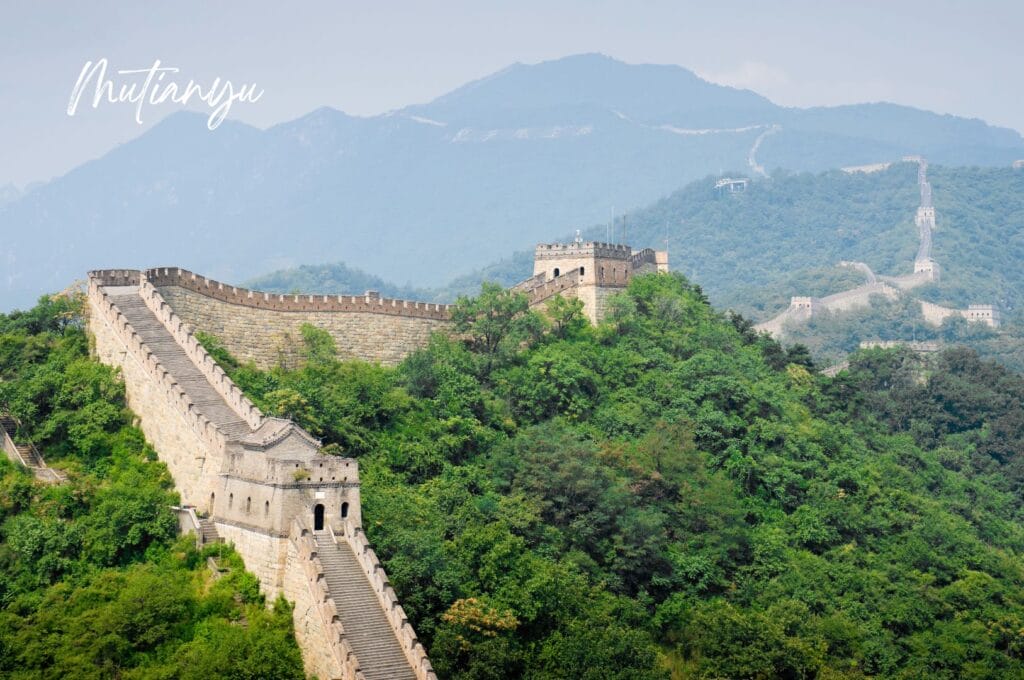
Central sector
The central sector extends between tower 14 and tower 6. To cover it, take the cable car (north entrance) or the chairlift (south entrance) and go down by toboggan, cable car, or chairlift. Covering this section takes about 2 hours.
Eastern sector
The eastern sector includes the first watchtowers of Mutianyu up to the 6th. It’s also the lowest sector in terms of altitude. The views are then less spectacular compared to the other two sectors. Take the chairlift at the south entrance, then go down to the first watchtower (Dajiaolou). Then, go down by toboggan or chairlift, or go back up to tower 14 to go down by cable car. In all, covering the eastern sector takes about 1 hour 30 minutes, and it takes about 4 hours if you go to tower 14.
Practical information
- Opening hours: Between March 16 and November 15, the Mutianyu site is open every day from 7:30 a.m. to 6 p.m. (6:30 p.m. on weekends), and from 8 a.m. to 5:30 p.m. the rest of the year.
- How to get to Mutianyu (1 hour 30 minutes from Beijing):
- With a tour: It’s the fastest and simplest way to get there. As Mutianyu is close to Beijing, there are plenty of tours, including a guided tour of the Wall. We recommend this one because it is flexible and inexpensive and includes transportation from the Chinese capital, the entrance ticket to the Wall, and the round-trip shuttle. In short, it’s really a good deal according to us! For other tour ideas, we recommend the Getyourguide site.
- On your own:
- By bus: The bus is the cheapest way to reach the Mutianyu roundabout. The main bus to reach the Wall section is the 916 (normal or express), the one that leaves from Dongzhimen, a few blocks from downtown Beijing (metro lines 2 and 13). This bus will stop at Huairou Beidajie station and you’ll have to take a minibus (H7, H23, H24, H35, or H36) that will drop you at the roundabout. In all, the trip should not cost you more than 20 yuan each. Otherwise, 2 other “tourist” buses leave from Beijing to go directly to Mutianyu. The first also leaves from Dongzhimen and leaves every day at 8:30 a.m. from exit B of the metro station. The second leaves from Qianmen station (north exit) and buses leave as soon as they are full from 8 a.m. For this kind of bus, count about 80 yuan per person for the round trip
- By private car: With a Didi, the equivalent of an Uber in China, count about 25-30 dollars for the one-way trip from downtown Beijing (50-60 for the round trip). Don’t hesitate to share the vehicle with other travelers! A taxi ride will cost a bit more. If you already have your tickets, ask your driver to drop you off at the top, at the entrance, rather than at the Mutianyu roundabout! It will save you the shuttle.
- Staying in Mutianyu: The village of Mutianyu has several hotels and inns, but beware of prices, which are higher than in Beijing!
- Price: On the official website, you’ll find several types of tickets. The basic ticket (Postcard Ticket) costs 45 yuan (60 yuan if you take the round-trip shuttle). In addition, you can add the round trip by cable car (140 yuan), one way (100 yuan), or take a combined ticket (200 yuan) with the shuttle and cable car. Warning: another company manages the chairlift and toboggan. Therefore, tickets for going up/down by chairlift and toboggan are purchased on site. If you want to slide down the toboggan, we recommend taking the Postcard Ticket and the cable car up, whatever sector you wish to visit.
- To visit the Wall at night, tours are normally scheduled during July and August, the hottest months, from 5:30 p.m. to 8:30 p.m.
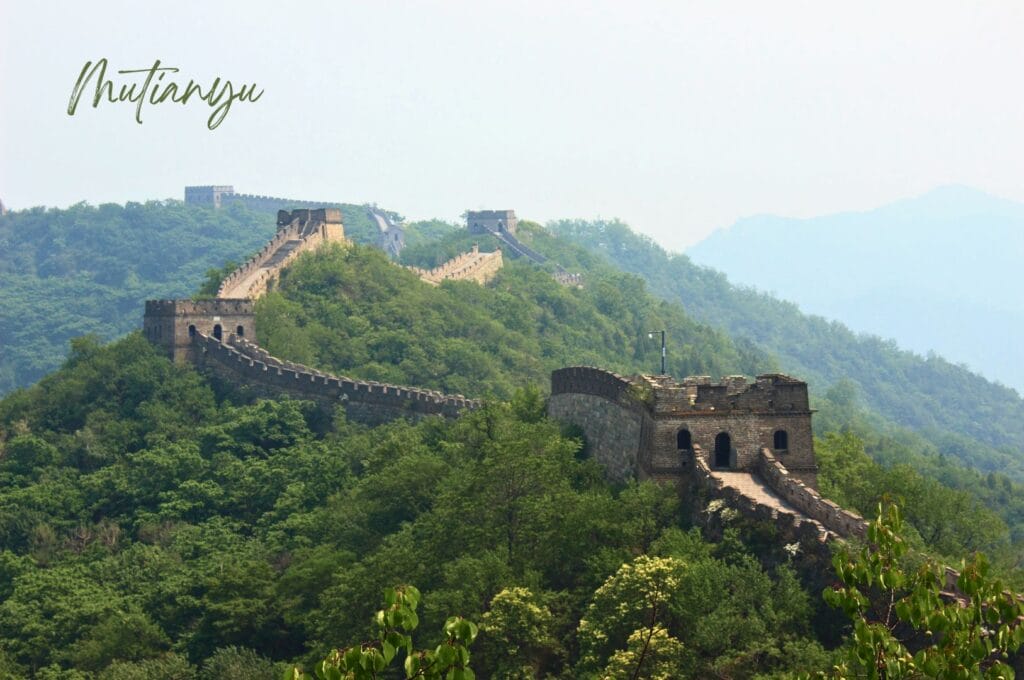
Dayingpan (or Yangbian)
Introduction to Yangbian
Although close to Badaling, Dayingpan is little known. It’s the highest portion near Beijing (only 62 km) with an altitude of 1100 meters. The only track we could find is this one. So, the Dayingpan Wall has not been restored since the Ming dynasty. As a result, it’s far from a walk in the park! Adventurous friends, be careful where you put your feet ;).
Practical information
- How to get to Yangbian (1 hour from Beijing): Apart from taxi (or Didi), the bus will be the best way to reach the Wall. Take metro line 8 and get off at Zhuxinzhuang station to take bus 880 towards Donghuayuanzhen. From there, ask for a taxi that will drop you directly at Dayingpan.
- Staying in Yangbian: The village of Henglingcheng is very small, the nearest hotels are those located next to Badaling.
- Price: Entrance is free :).
Huanghuacheng
Introduction to Huanghuacheng
The only part of the Great Wall that is accessible to the public, bordered by water and even submerged, Huanghuacheng deserves to be a bit better known! Nicknamed the Lakeside Great Wall, this section is very little frequented by tourists.
In short, Huanghuacheng is:
- a 13 km portion built in 1404 under the Ming dynasty, not fully restored, which extends between Lake Haoming and Huanghuacheng Reservoir with submerged sections
- a colorful landscape with the blossoming of yellow flowers in early summer
- a magnetic slide
- the opportunity to take a boat tour to discover another facet of the Great Wall of China
- a half-day visit (about 4 hours)
- 81 km to travel from Beijing (1 hour 30 minutes by road)
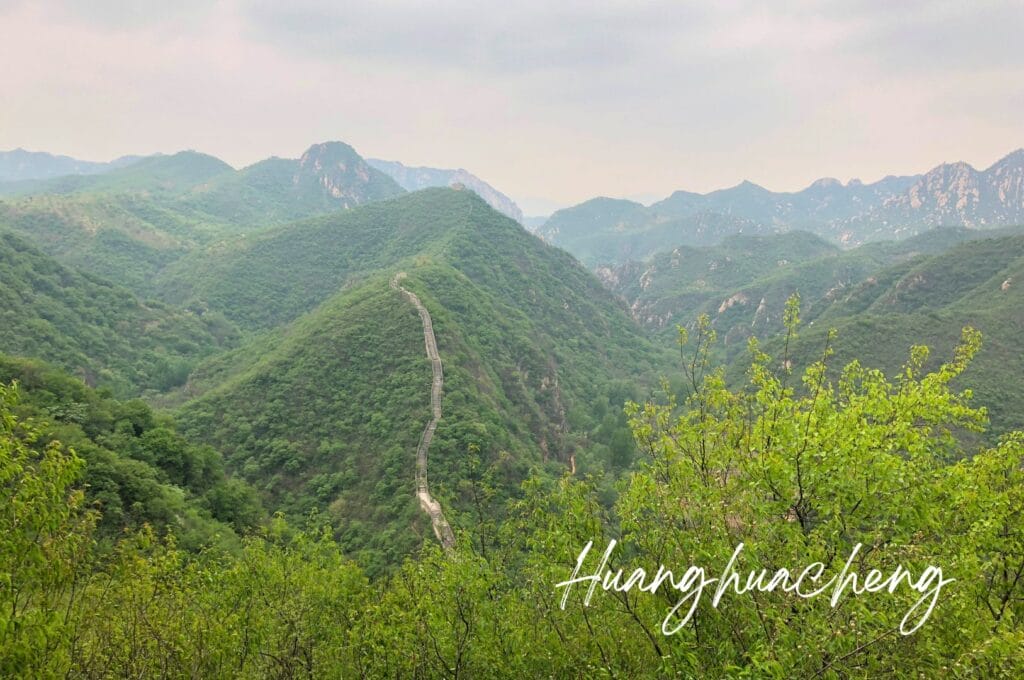
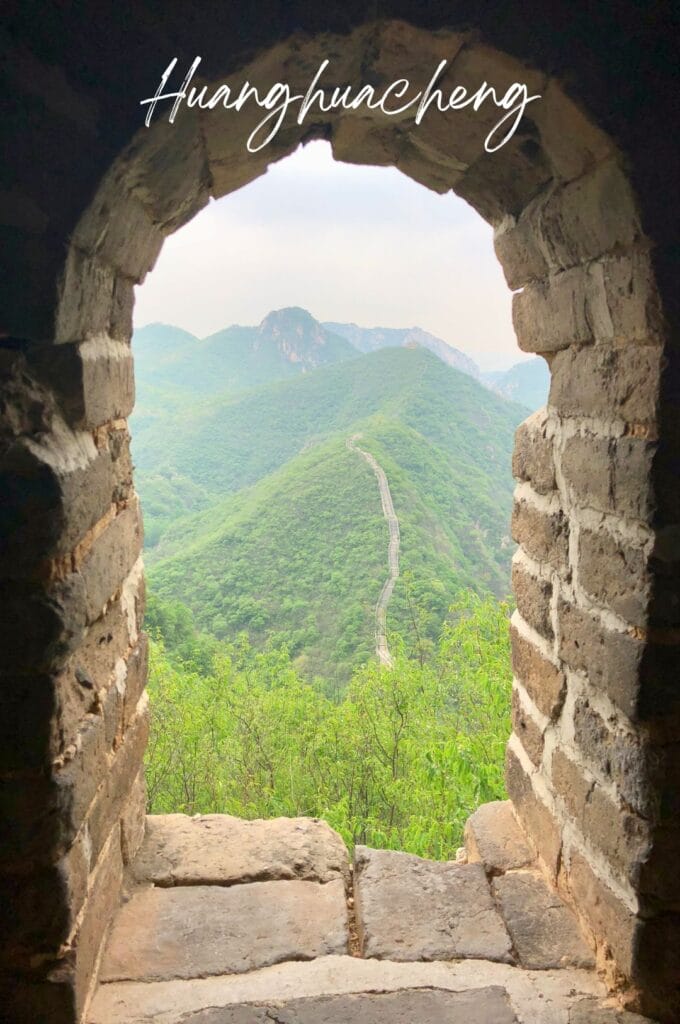
Map of Huanghuacheng
Here is a map of Huanghuacheng to help you navigate. We’ve indicated the route of the 2 hikes to explore the area; the one in red is the most popular.
Visiting Huanghuacheng
To visit Huanghuacheng, you have 2 choices: do everything on foot or do part of it walking and the rest by boat and/or in small wagons on the magnetic slide. The points of interest are:
- the submerged portions of the Wall;
- the dam;
- the peninsula and its small port;
- the chestnut garden that is several centuries old;
- the glass bridge.
So, as on all the Wall, it climbs due to the stairs but much less than Juyongguan, for example. You can shorten the walking time by taking the boat and going directly to the chestnuts rather than going to the basins in the west. In total, this will make a 4 km loop by opting for these shortcuts :).
Practical information
- Opening hours: From 8 a.m. to 5 p.m. (between April 1 and October 31), from 8:30 a.m. to 4:30 p.m. the rest of the year.
- How to get to Huanghuacheng (1 hour 30 minutes from Beijing):
- With a tour: According to us, there is only one excursion to remember according to us, it’s this one. For a more than correct price, this formula includes round-trip transportation from Beijing, an English-speaking guide, entrance tickets for the Great Wall, and a boat tour on Lake Haoming.
- On your own:
- By bus: The simplest way is to take bus 916 or 916 express from Dongzhimen to Huairou. Then, take bus H21, which will take you to the edge of the Huanghuacheng Wall.
- By private car: With a Didi, the equivalent of an Uber in China, count about 40 dollars for the one-way trip from downtown Beijing (70-80 for the round trip). Don’t hesitate to share the vehicle with other travelers! A taxi ride will cost a bit more.
- Staying in Huanghuacheng: If you have your own tent, the Huanghuacheng camping at the western end of Lake Haoming is perfect for a unique experience. Otherwise, we’re sure you’ll find the place that’s right for you among all the accommodations around the lake!
- Price: Entrance to Huanghuacheng is 60 yuan per person, to be purchased on-site or online. For activities on-site, count about 30 yuan for the one-way boat trip and 80 yuan for the magnetic slide.
Jiankou
Introduction to Jiankou
So, this portion is reserved for experienced hikers! Located between Mutianyu and Huanghuacheng, Jiankou is undoubtedly the steepest accessible part of the Great Wall of China. It even exceeds 1000 meters altitude in some parts! It’s not for nothing that it’s called the “Vertical Great Wall” ;). However, we are far from the safety of the restored sections. Here, some passages are steep, eroded, abandoned and vegetation is slowly beginning to reclaim its rights in this beautiful mountainous region… And the hike even turns into climbing in some places. In short, it’s the most dangerous section of the Wall.
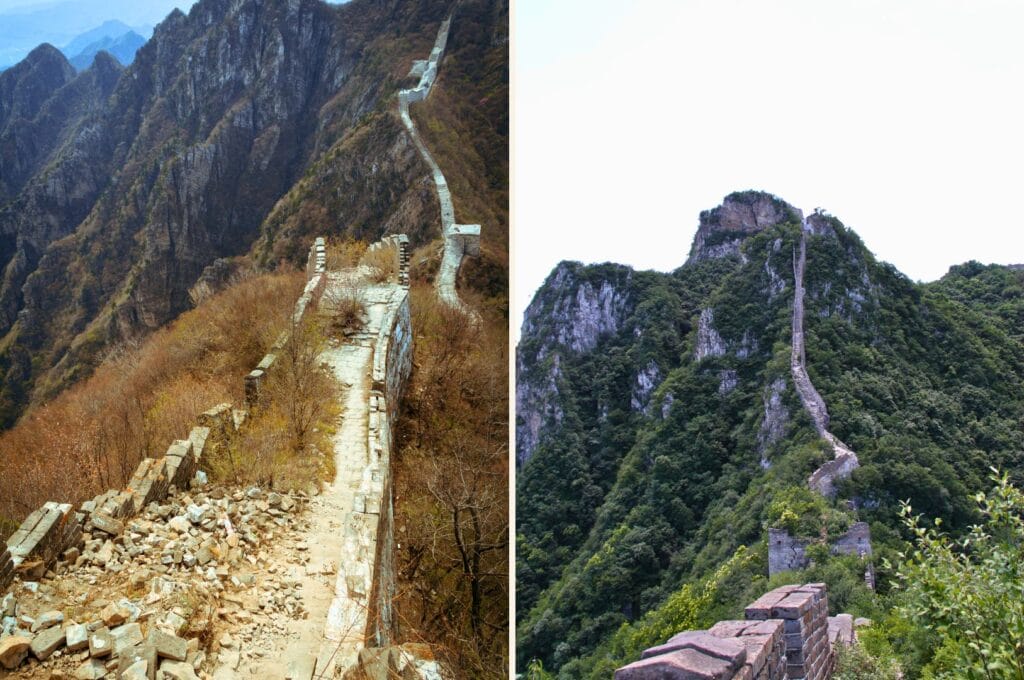
For all these reasons, the section is theoretically forbidden to hikers and guards patrol from time to time. So it’s up to you to try to access the Wall. Some have been lucky (especially by arriving early) and others not… To visit Jiankou more safely, we therefore recommend taking a guide.
After this introduction, you’ll understand why few travelers venture into the area. We recommend Jiankou only if you have done other portions of the Wall and wish to discover a bit more of its wild side.
In short, Jiankou is:
- a portion of the Great Wall of China dating from the 1300s (Ming dynasty), not restored
- a vertiginous mountainous setting for adventurers or experienced hikers
- a half-day visit
- 95 km to travel from Beijing (2 hours by road)
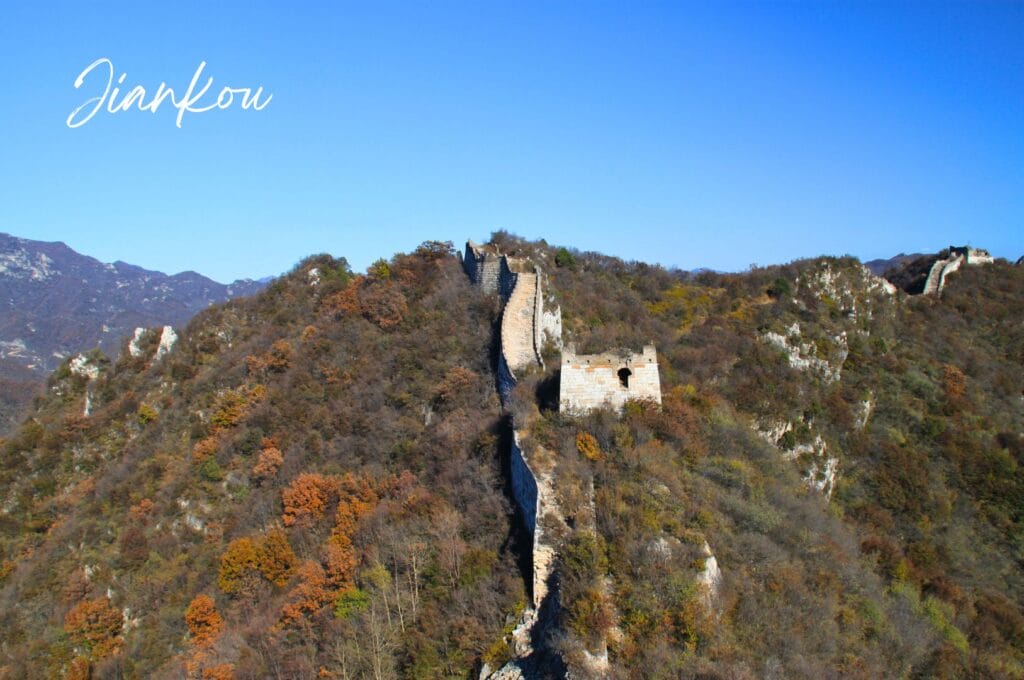
Map of Jiankou
To help you navigate the region, here is the map of Jiankou with the 2 possible paths:
- The green one corresponds to the passage between Jiankou and Mutianyu.
- The red one is the one that goes around the area and is more difficult.
Visiting Jiankou
Like the rest of the Wall, several watchtowers punctuate the Jiankou section. Some are still in fairly good condition. The most famous is the Zhengbeilou tower, a spot renowned for sunrises and sunsets and prized by photographers. Among the other peculiarities of the area, we’ll mention the Beijing Knot, the crossroads where 3 sections of the Wall meet; the 9-eye tower, a former command post located in the north at an altitude of 1100 m; and the sky ladder, very steep as its name suggests!
As Jiankou is located not far from Mutianyu, it is theoretically possible to cover the Wall between the two. However, it seems that some parts are closed or that a guard watches from the Jiankou side. In all, the path that connects the 2 is 5.7 km long with a 490 m positive elevation gain. Count a good 2 hours of walking. To give you an idea of the route, refer to the map below.
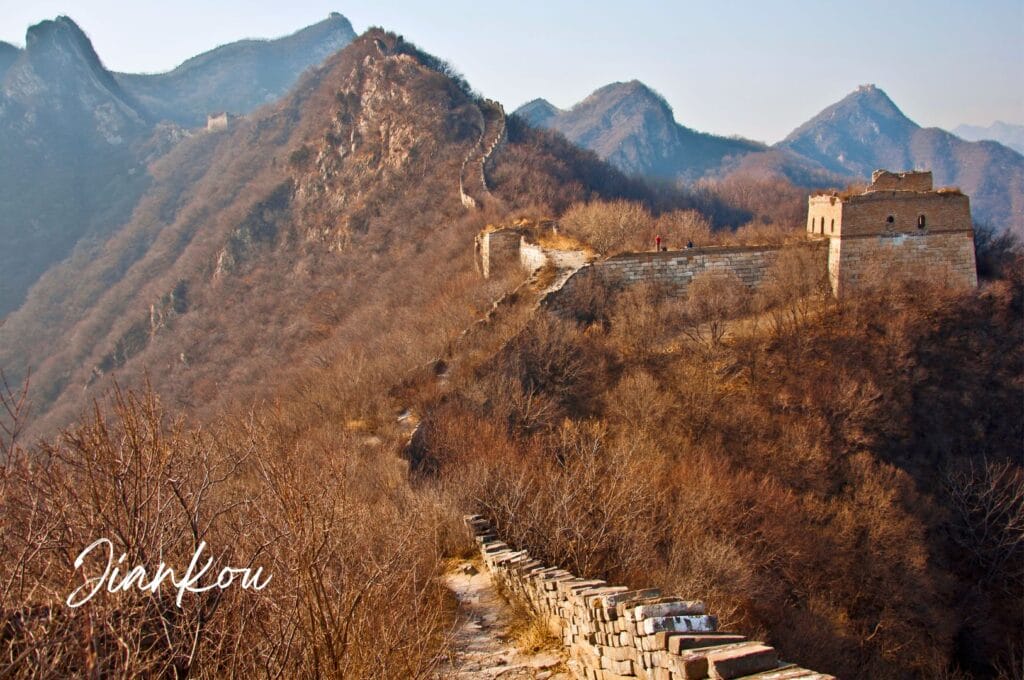
Practical information
- Opening hours: Few controls, so no opening hours.
- How to get to Jiankou:
- With a guided tour: We recommend this circuit for a day under the sign of adventure!
- On your own: The Jiankou Wall is located at the level of Xizhazi village and the simplest way to get there from Beijing is to take the bus. For this, you need to go to Dongzhimen (metro lines 2 and 13). Then, get on bus 916 or 936 and get off at Huairou (about 1 hour 30 minutes journey). Finally, you’ll have to take the H25, which leaves from the Yujiayuan Yiqu stop in Huairou (schedule: 11:30 a.m. and 4:30 p.m.) to arrive directly at Xizhazi village. If you’re on the 916, you’ll have to walk from this point to that stop. The 936 will drop you directly at the right stop in Huairou. Otherwise, you can take a taxi from Huairou but it’s a bit more expensive… Count about a hundred yuan.
- Getting to Jiankou from Mutianyu: From the roundabout, buses H24 and H23 shuttle between Mutianyu and Huairou. From there, you’ll have to take the one and only H25 :).
- Staying in Jiankou: Only 2 establishments are located in the surrounding villages (Haiyan Farmstay and Simple garden house).
- Price: This section is free, but villagers may ask you for a few yuan to climb on the wall via unofficial entry points.
Gubeikou
Introduction to Gubeikou
Located northeast of Beijing, Gubeikou is a little-known section of the Great Wall of China. The Gubeikou pass was strategic in the defensive role of the Great Wall and many battles took place at its level. It’s up to you to discover the stigmas in the structure of the Wall! Like Jiankou, this segment of the Wall has not been renovated since the 1500s and offers a more rustic visit than the most popular sections. However, although located on Yanshan Mountain, we are far from the steep slopes of Jiankou. It is therefore more accessible but the landscapes are perhaps a bit less impressive.
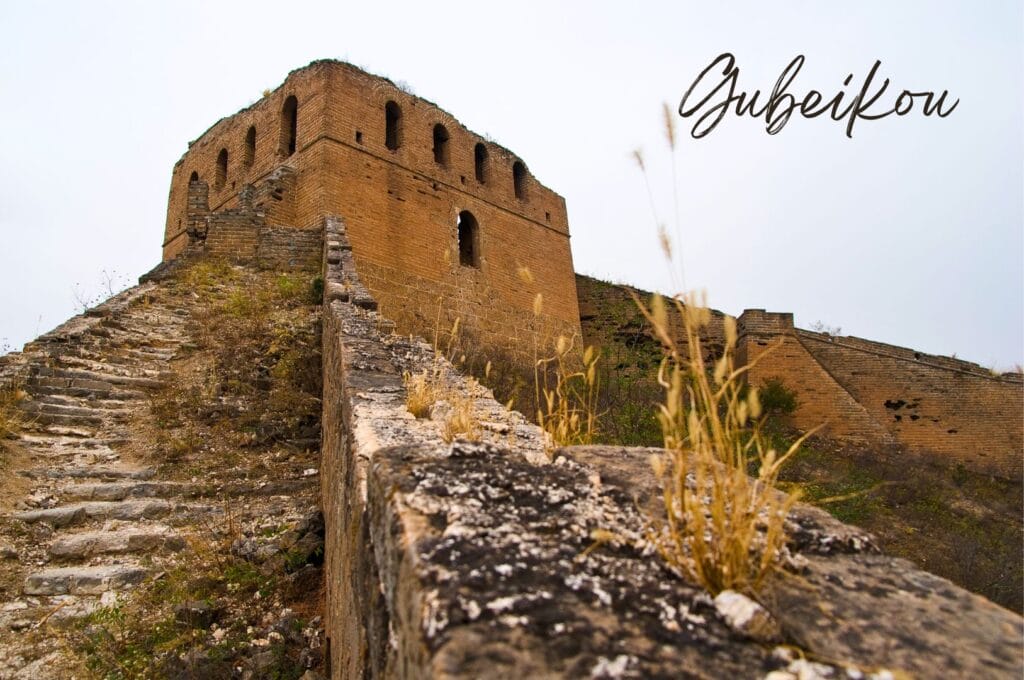
In short, Gubeikou is:
- a 40 km section of the Great Wall of China dating from the 500s (Northern Qi dynasty), restored under the Ming dynasty
- more than a hundred watchtowers
- a wild section
- a half-day to a day visit
- 140 km to travel from Beijing (2 hours by road)
Map of Gubeikou
On the map below, we have indicated the itinerary to visit Gubeikou and the path that connects the site to Jinshanling.
Visiting Gubeikou
So, Gubeikou is divided into 2 parts: Wohushan to the west and Panlongsha to the east. You can explore both, but it takes time to do the round trip. Alternatively, since Gubeikou is connected to Jinshanling, a day hike is a great way to visit both the unrestored and restored Wall. To help you choose your route, we’ve detailed all the possibilities and points of interest.
Wohushan
Wohushan is the western part of the Gubeikou section. Wilder and steeper than the east, it stretches 10 km and includes 40 watchtowers. Today, only a few kilometers are accessible on foot. From Gubeikou station, it takes a good 45 minutes to walk the 3 km leading to Wohushan’s highest point at 665 m altitude (380 m elevation gain).
Palongsha and the hike to Jinshanling
Palongsha is the eastern part of Gubeikou and the most popular. On this side of the valley, the elevation gain is less. You can choose to stop at the 24-window tower and turn back or continue to the Jinshanling Wall. In the first case, the trail is 7 km from Gubeikou station, and in the second case, you’ll walk an additional 7 km from the tower (5 hours, 750 m elevation gain). Whatever your choice, you can take a taxi that will drop you at the beginning of the trail (saving you a good 2 km) or at the second entrance (see map).
To get to Jinshanling, you’ll need to bypass a military zone by following the route on the map. Once at Jinshanling, you can stay overnight or catch a taxi to take the train at Gubeikou (the last train is at 5:20 p.m.). It’s quite doable in a day if you start early enough ;).
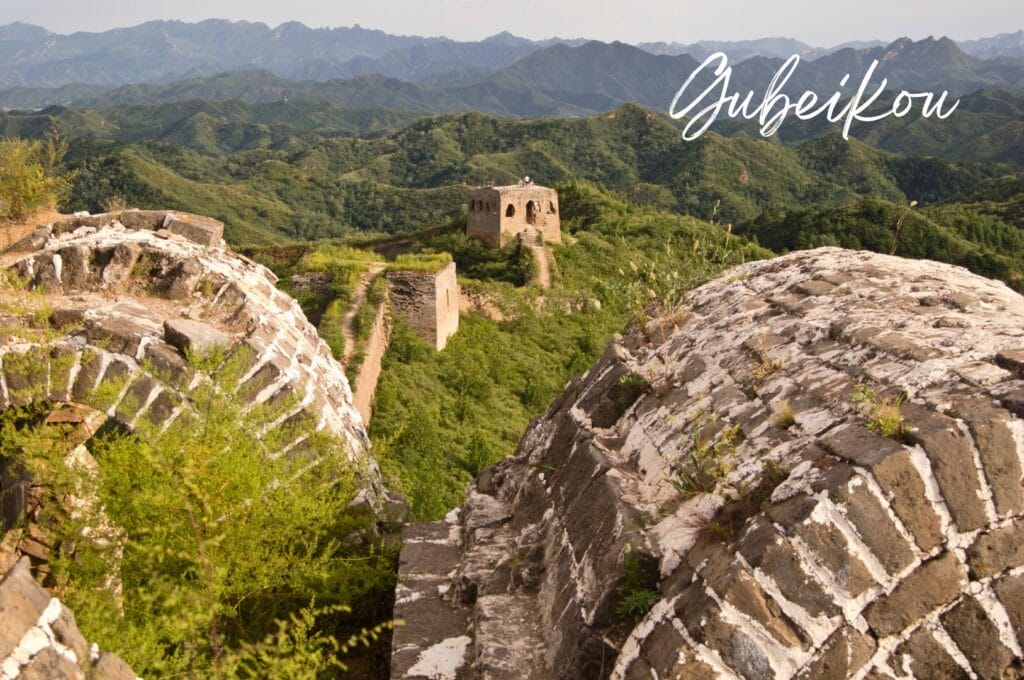
Practical information
- Opening hours: Like all wilder sections, there are no specific opening hours.
- How to get to Gubeikou: For this section, we recommend getting to Gubeikou on your own. It’s easy and much cheaper than taking a tour that only offers transportation, not a guide.
- By train: The big advantage of the Gubeikou section is that it’s accessible by train! From Qinghe station (subway line 13) or Beijing North station (subway lines 2, 4, or 13, Xizhimen stop), trains make the journey in just over 2 hours (check schedules here).
- By bus: Otherwise, the bus is always a safe bet! From Dongzhimen (subway lines 2 and 13), take bus 980 to Miyun, then get on bus 25, which will drop you at Gubeikou. The one-way trip should cost about 30 yuan.
- You can always take a taxi or Didi, but watch the price! Count at least 1000 yuan for the trip.
- Staying in Gubeikou: It probably has the best accommodation options among the unrestored sections of the Wall. Compare prices directly on Booking.
- Price: Entrance costs 33 yuan per person.
Shanhaiguan (or Laolongtou)
Shanhaiguan is where the Great Wall of China meets the sea! Yes, this is where the famous ramparts begin in the east, from the Bohai Gulf. To be honest, apart from walking on this small restored section of wall, photographing it, and enjoying the beach, there’s not much to do in this area. Is it worth taking more than 2.5 hours of train to see the eastern end of the Wall? Hmm, we doubt it… Entrance costs 50 yuan per person. Check train schedules to Qinhuangdao on this page. Once you arrive at the station, a taxi will take you to the Shanhaiguan site.
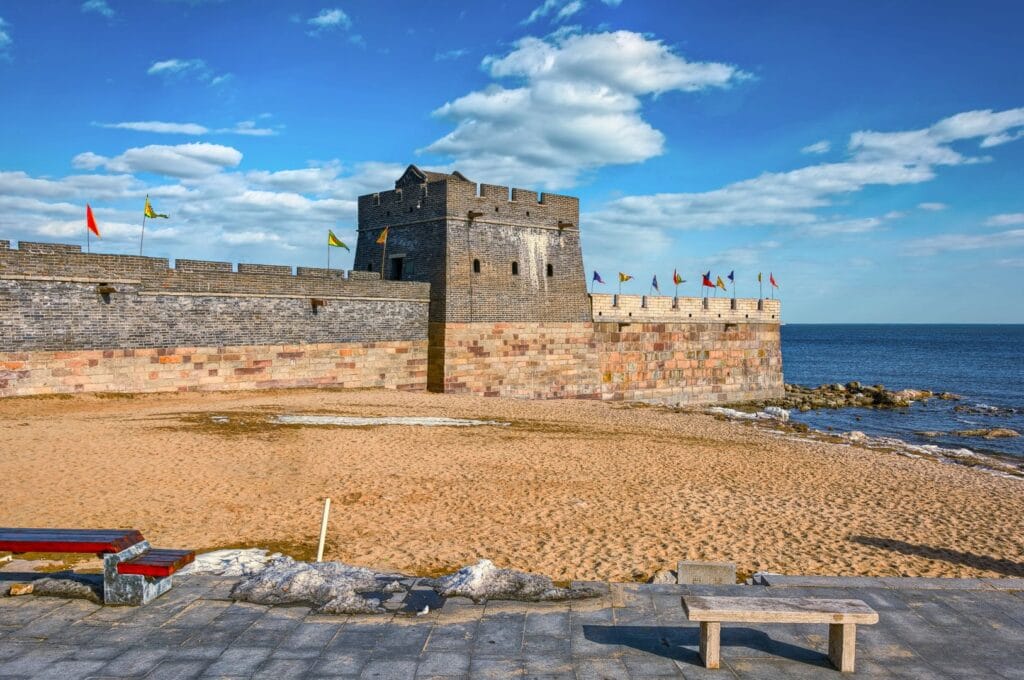
Jinshanling
A little further to the southeast, we find ourselves at Jinshanling, a beautiful half-restored section that’s really worth seeing, in our opinion! It’s far from the crowds, and you can choose to do a day hike starting from Gubeikou (14 km) or visit Jinshanling and Simatai on the same day! We chose the latter option. At the time, the section between Simatai and Jinshanling was closed for construction but still accessible! As a result, we were able to walk on the Wall without tourists. Today, the passage between the two is blocked, but that doesn’t stop you from doing both places in one day and enjoying a magnificent panorama, still without the crowd! It’s one of the portions furthest from Beijing, which always discourages travelers from coming here ;).
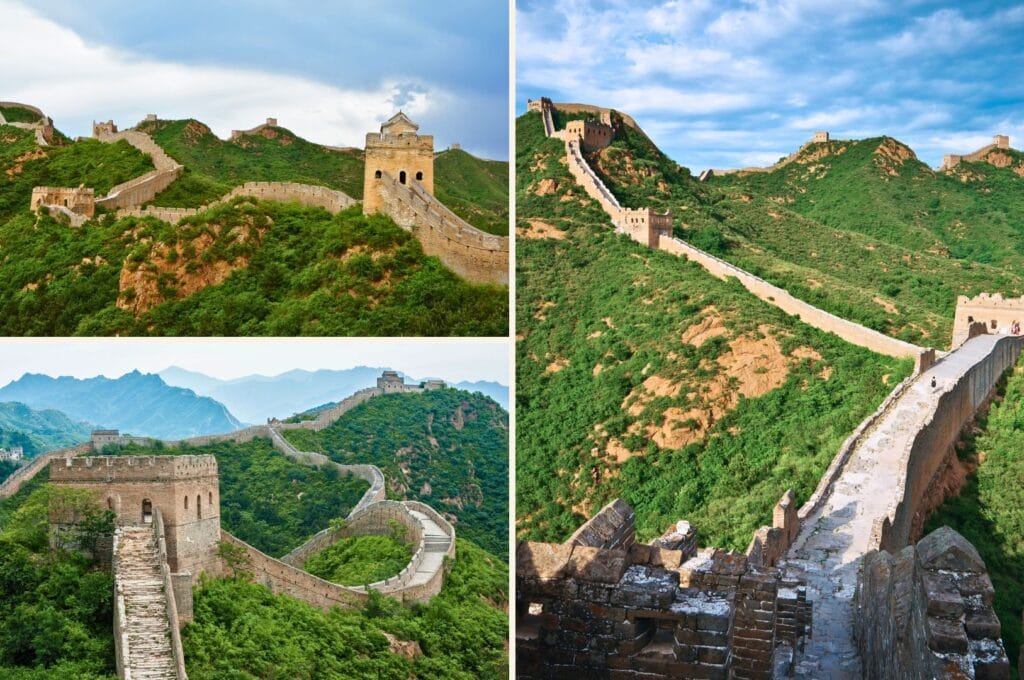
In short, Jinshanling is:
- a 10.5-km portion of the Wall built in the 16th century (Ming dynasty), partly restored
- authentic and surrounded by nature
- home to more than 30 watchtowers, one of the most fortified sections!
- very few tourists
- a cable car
- a day of visiting
- 120 km from Beijing (2.5 hours by road)
Map of Jinshanling
On the map below, find all the important points for hiking in the area.
Visiting Jinshanling
The Jinshanling Wall is divided into 2 parts, east and west, with 3 entrances (main, east, and west). Basically, the western part is less renovated, while the east is a nice mix of old and new. You have plenty of choices when it comes to routes! But be careful, it’s steep and there are many steps! Having good physical condition is therefore recommended even if there is a cable car.
From the main entrance (central), you can:
- Take a shuttle to get to the east or west gates if you want to explore all of Jinshanling;
- Take the cable car or walk to do only the east or west section.
Tip: Are you in a taxi? Ask your driver to drop you off at the east or west entrance and pick you up at another entrance ;).
The shortest hike (in red on the map above) will show you the best of Jinshanling. You’ll start from the main entrance and take the well-renovated part of the Wall. Take the cable car to the Xiaojinshan tower, pass through the General tower and go to the Zhuanduokou tower (Brick Crenel) to walk back down to the parking lot. In total, this tour is 5.8 km with less than 200 m of elevation gain. Count a good 2.5 to 3 hours for this hike. To extend the visit, continue 700 meters further to the Taochun tower and take the stairs to the entrance. The tour will then be about 6.7 km.
For the more athletic, climb to the East-Five Window tower from the east entrance, turn right to the western end of Jinshanling at the Longyukou tower and descend to the west gate, where the shuttle will take you back to the main entrance. Note: You might read Simatai West on the maps, but it’s actually Jinshanling East :). This makes for a good 7.3 km walk with 320 m of elevation gain, it’s the green route on the map. We recommend doing it from east to west because it’s mostly downhill in that direction. Count a good 4 hours for the visit.
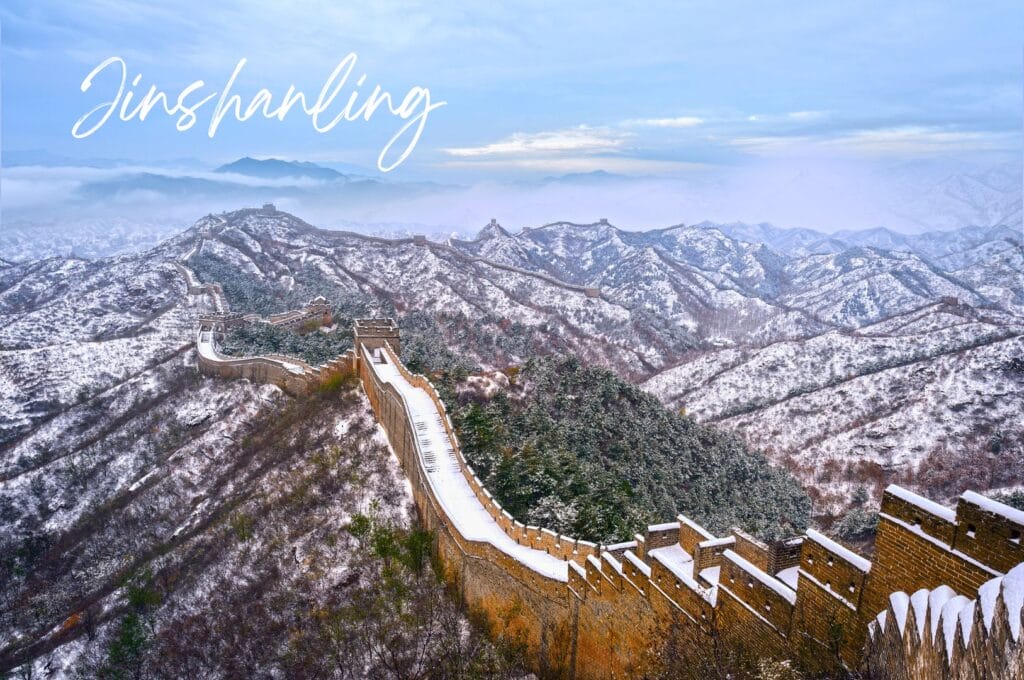
Hiking between Jinshanling and Simatai
As for the portion between Simatai and Jinshanling, it seems it was open for a while before being closed for good… Instead, we recommend hiking between Gubeikou and Jinshanling or leaving early from Beijing to arrive at opening time at Jinshanling, visit the ramparts, then take a taxi to Simatai and spend the night there to have both sunset and sunrise on the Wall :).
Practical information
- Opening hours: In high season (from mid-March to mid-November), 4 a.m. to 6:30 p.m. for the central gate (8:30 a.m. for the east gate and 9 a.m. for the west gate) and the rest of the year, 6 a.m. to 5 p.m. for the central gate and 9:30 a.m. for the other two entrances.
- How to get to Jinshanling:
- With a guided tour: Several tours are worth it in our opinion. This one has an excellent value for money if there are several of you, with private transportation and guide included. Otherwise, this all-inclusive excursion has a big plus: You leave at 7 a.m. from Beijing to arrive early at the Wall! Finally, if you want to watch the sunset and return to Beijing right after, we recommend this tour (ticket, transportation, guide, dinner included).
- On your own:
- By bus: The bus won’t be the same whether you travel during the week or on weekends and holidays. In the first case, take bus 858 next to the sign saying “Jinshanling Great Wall” at the Bafangda bus station (Wangjingxi station, yellow line 13 and dark purple line 15). With departures every 30 minutes from 7 a.m., it goes to Luanping, where you’ll take a minibus or taxi to the Great Wall. In the second case, you’ll need to take bus 8, which leaves every day at 8 a.m. from Dongzhimen here (subway lines 2 and 13, exit E). It will drop you at the main entrance of Jinshanling and will leave at 4 p.m. from the same place to return to Dongzhimen.
- By train: We refer you to the practical info on Gubeikou and the train journey. Once at Gubeikou, take a taxi (12 km) or walk on the Wall to Jinshanling.
- Staying in Jinshanling: To enjoy the place early in the morning, we recommend staying near the Wall in one of these establishments or the camping area. All accommodations are located around the main entrance.
- Price: The ticket fare is 65 yuan in the high season and 55 yuan per person during the rest of the year. The shuttle trip costs 10 yuan one way and 20 yuan round trip, and the cable car tickets cost 40 yuan one way and 60 yuan round trip per person.
Simatai
Simatai was our starting point for visiting the Great Wall of China off the beaten path! We opted for a small inn located just a few meters from the Wall, not far from Dongpo village. Today, the guesthouse has become much more modern and access to the Wall can no longer be done on the sly. However, we still believe it’s an excellent place to base yourself and see the Wall peacefully. Even if the section is now open to the public, it remains far from Beijing and therefore, much less crowded than Badaling or Mutianyu. You’ll cross paths with a handful of travelers at most!
The best thing, if you’re coming from Beijing, is to leave the city around noon. This way, you’ll arrive at the inn in the mid-afternoon and have plenty of time to settle in before going to admire the sunset.
As we wrote in the Jinshaling section, the passage between the two is now closed, but you can easily visit both in the same day.
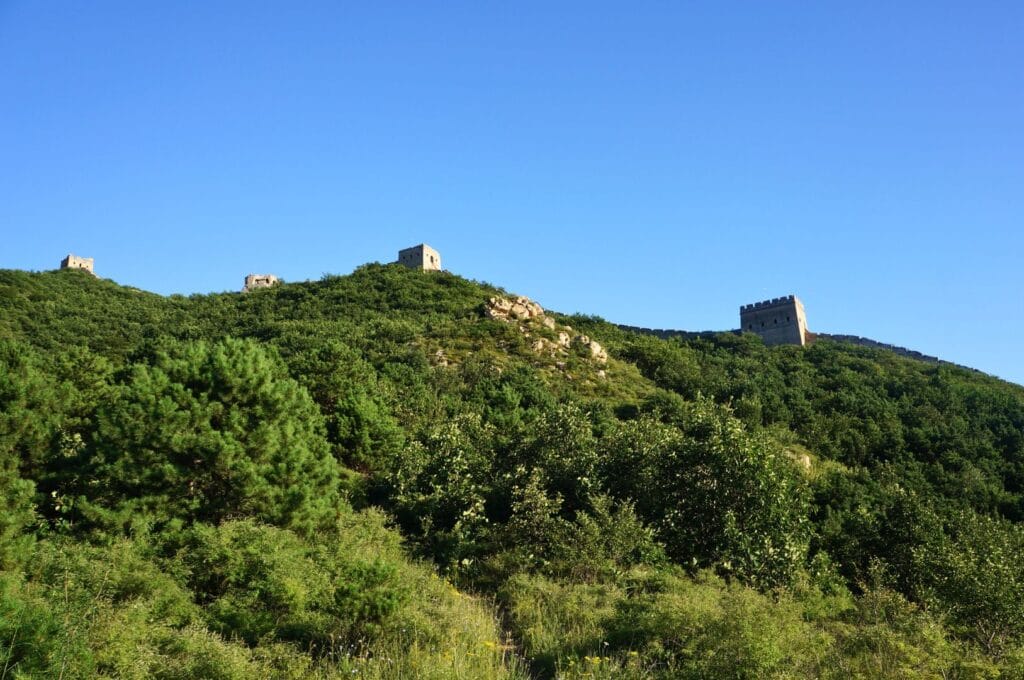
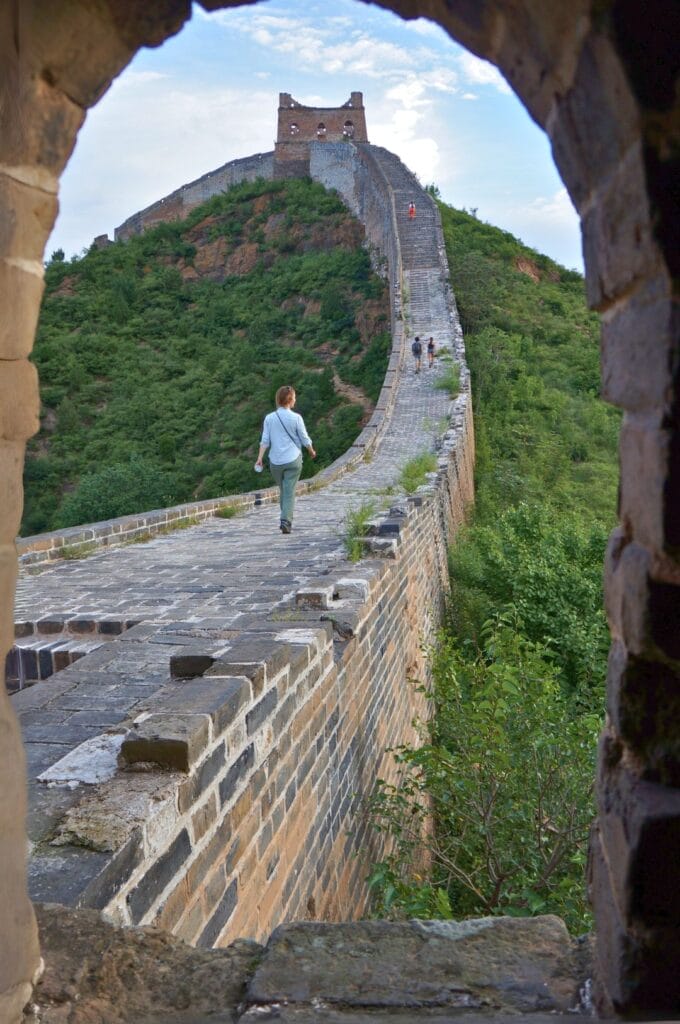
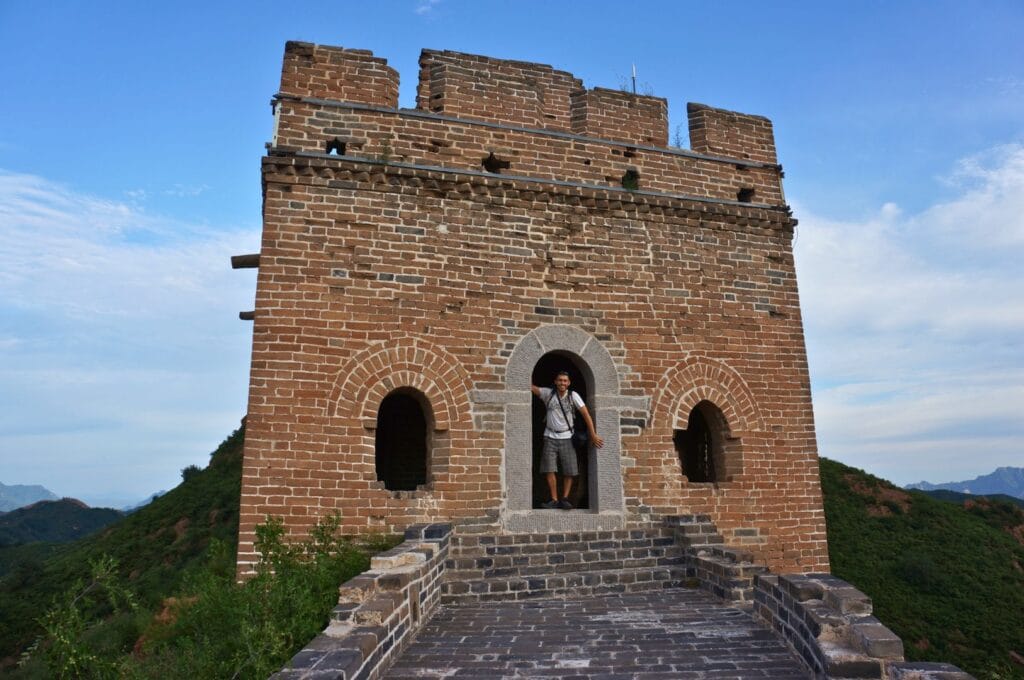
In short, Simatai is:
- a 5.4 km portion of the Great Wall of China, built during the Northern Qi dynasty (6th century) and renovated during the Ming dynasty
- 20 watchtowers
- authentic and surrounded by nature
- few tourists
- a cable car
- a half-day visit
- the possibility of seeing the illuminated ramparts and walking on the Great Wall of China at night
- 130 km from the capital (2.5 hours by road)
Map of Simatai
Here’s the Simatai plan with the tour route and important points.
Visiting Simatai
We highly recommend going through the inn to organize your visit! On the program, a sunset and sunrise that will take your breath away! We’ll tell you a bit more below about this authentic experience that will mark us for life.
If you’re staying in southern Gubei (see practical info), shuttles go back and forth to the entrance of the Simatai Wall. The fare is 10 yuan each. Otherwise, expect about 20 minutes of walking to the ramparts.
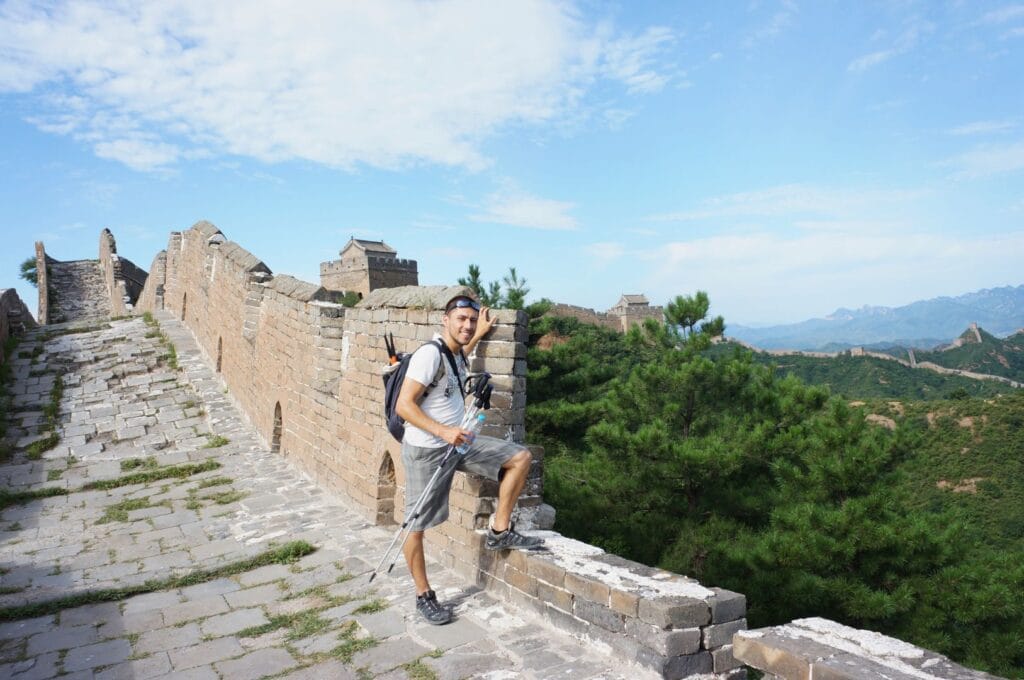

Here, only watchtowers 2 to 10 are accessible. Continuing westward, you would reach Jinshanling East (also called Simatai West). To the east, towers 15 and 16 (Fairy and Wangjing towers) rise to nearly 1000 m altitude, but they are also closed to the public.
If you do everything on foot, the 4.5 km tour takes about 3 hours. The slope is relatively gentle up to tower 5, with a good number of steps, and after that, it climbs steeply! Otherwise, the cable car allows you to access watchtower number 8 directly, and it’s flat until tower 10. Then, you just have to go down to tower 2 and along the reservoir to return to the site entrance (or take the cable car back).
One of the attractions of Simatai is the illumination of the Great Wall of China and the possibility of walking on the fortifications once night has fallen! For more info, read what follows ;). If you have a little more time, boat tours are offered on the reservoir that borders the ramparts.
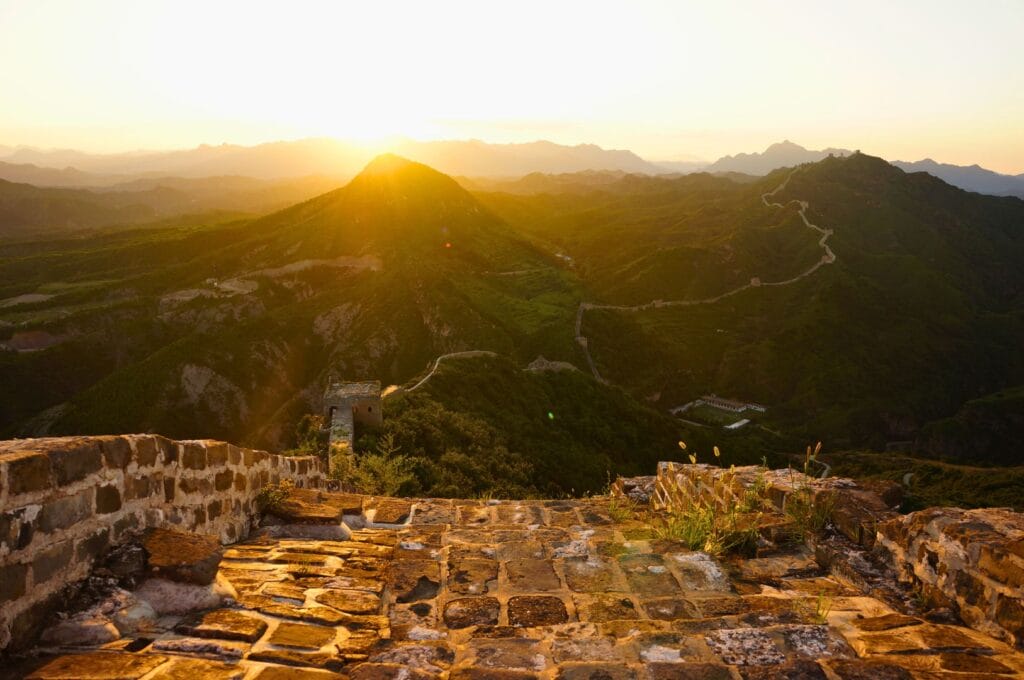
Sunset on the Great Wall of China
So it was around 3 p.m. that we arrived at what would be our little oasis of happiness for the next few days. After a well-deserved first cold beer, we set off for Simatai. From the inn, it takes about 5 minutes through small woods to reach a high point of the wall that will offer you a breathtaking view!
The only people we met were 3 Chinese workers who were coming down from the Wall after their workday. In the evening, you’ll probably be alone in this place! Once on the ramparts, don’t be intimidated by the very steep stairs. After this magnificent spectacle, we went back down to the inn to enjoy an excellent meal prepared by the master of the house!
Note: For visits at dusk, only towers 5 and 6 are accessible.
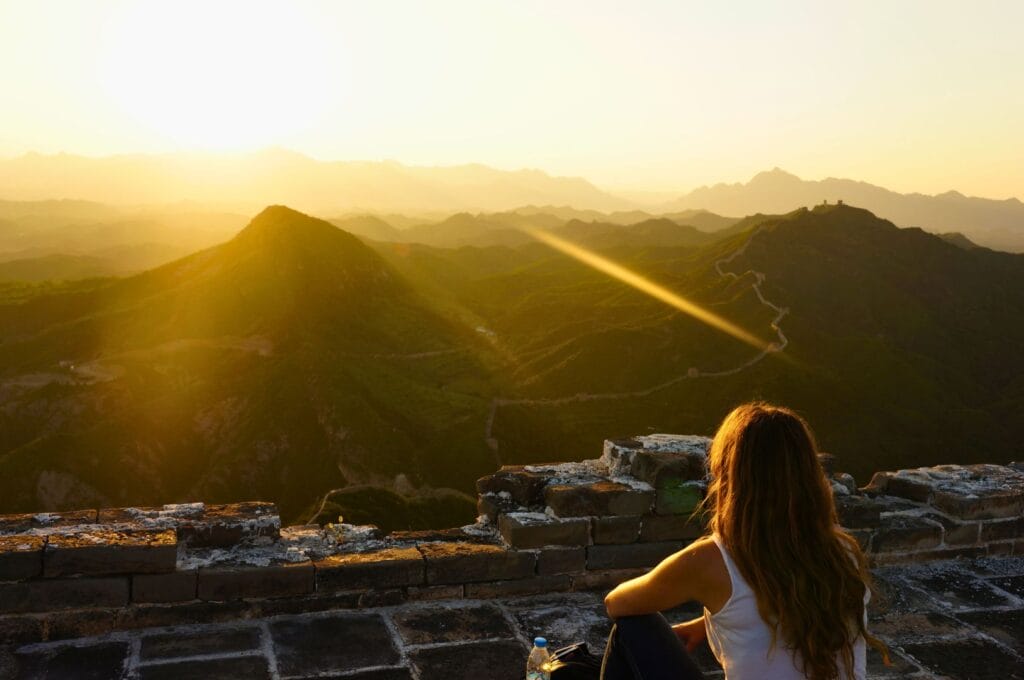

Sunrise and hike to Jinshanling
I’m not really a morning person, but that day, Benoit didn’t have to make extra efforts to get me up at 5 a.m.! I was like a child on Christmas Day: I wanted to see my sunrise on the Great Wall of China! So after a good breakfast, we set off around 5:30 a.m. with a Canadian couple we met at the inn.
By the time the first rays of the sun began to peek over the surrounding hills, we had already climbed several hundred good meters. Apart from the 4 of us? Absolutely NO ONE on the Wall as far as the eye could see! I think I’ll never forget that incredible feeling of freedom and immensity that overwhelmed us at that moment!
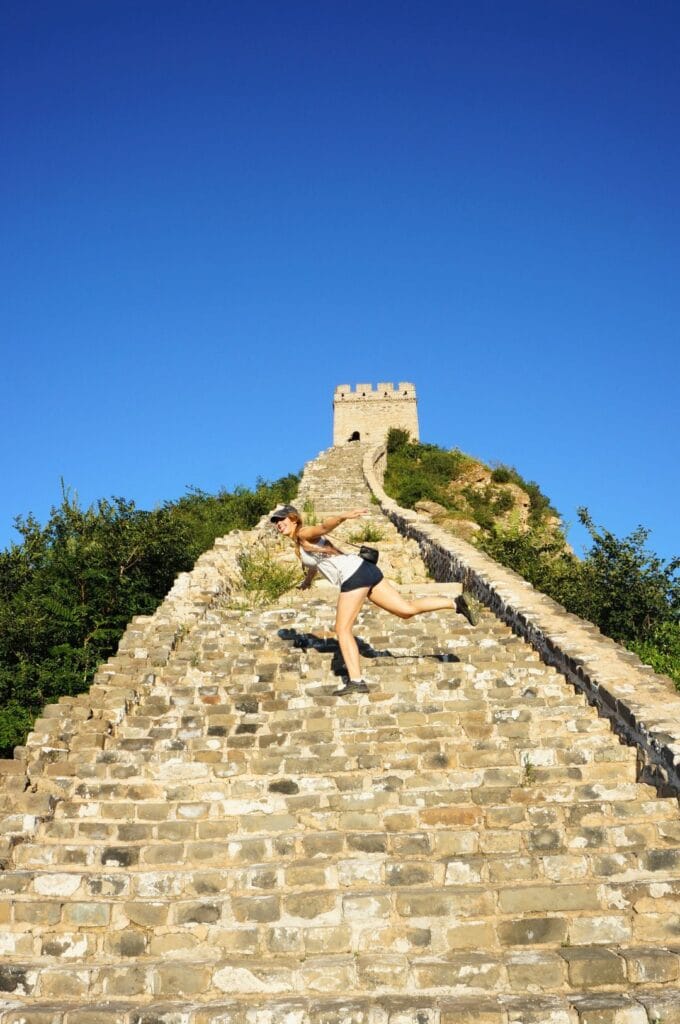
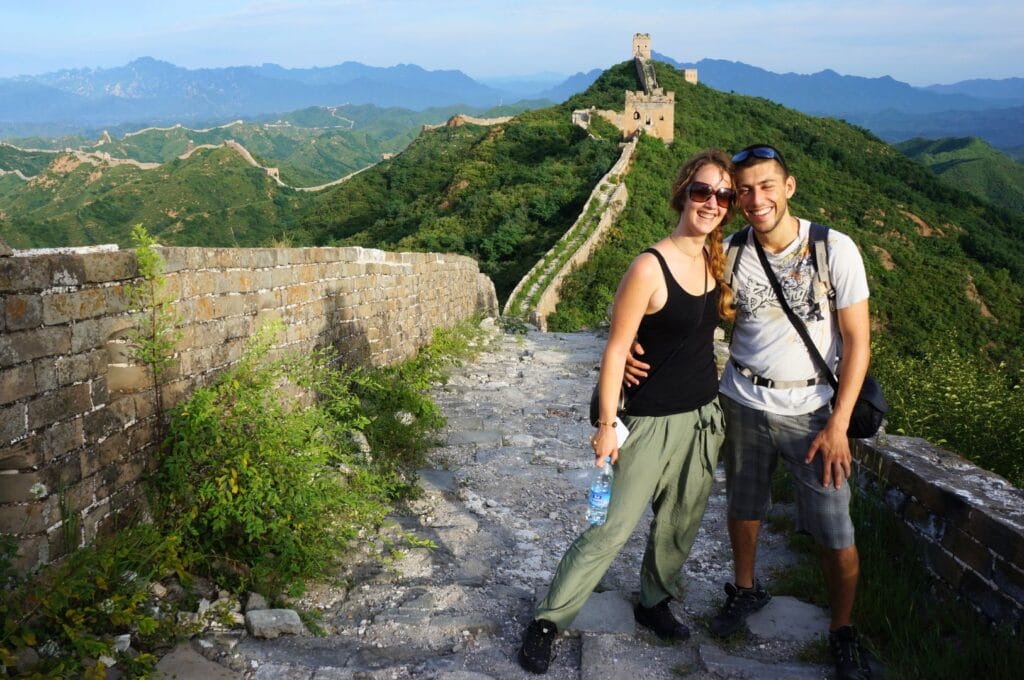
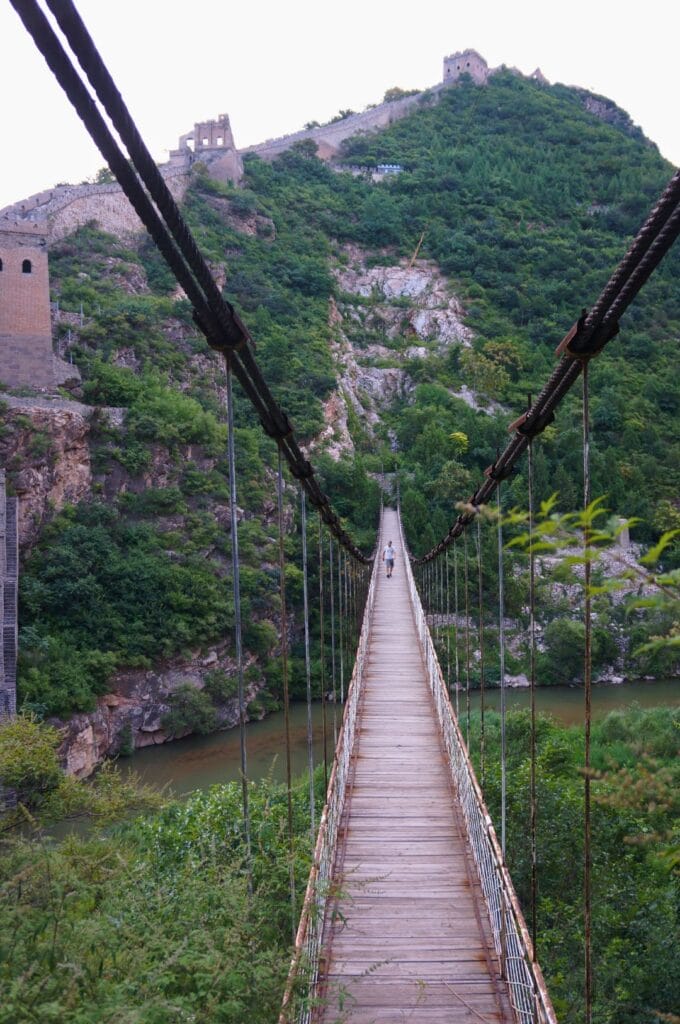
After sunrise, the walk continues peacefully with the sun at our backs until Jinshanling. For nearly 3 hours, we didn’t meet a living soul! Our first encounter was with an old man of 75. This gentleman climbed alone on the Great Wall with a small backpack filled with water, beers, and coffee to supply the few strollers who would venture there later in the day!
As we approached the Jinshanling cable car, the first tourists appeared. But rest assured, these are just a few isolated people, we’re far from the human tides you might encounter at Badaling! Especially since for us, it’s almost the end of the walk… Yes, 4 good hours of scrambling on the Wall, climbing steps that are half your height and sometimes going down almost vertically, I guarantee it’s tiring! The inn owner will come to pick you up to take you back either to the inn, to the bus, or your hotel, depending on what you’ve arranged with him.
So it was around noon that we returned to our inn, tired but so happy! You understand why we advise you to spend a night on site :).

Practical information
- Opening hours: Simatai is open from 9 a.m. to 4:30 p.m., night visits start at 5:30 p.m. and end at 9:30 p.m.
- How to get to Simatai:
- With a guided tour: We recommend this excursion for its good value for money (especially if there are several of you)! On the program: transportation, English or French-speaking guide, visit to Gubei Water Town and the Great Wall, and sunset!
- On your own:
- By train: From Beijing, you can take the train to Gubeikou (see practical info for the section), then a shuttle will drop you at Gubei.
- By bus: If you’ve booked a night in the same inn as us, someone will pick you up directly at Jinshanling. Therefore, we refer you to the practical info for this section. You can also reach Jinshanling and take a taxi to Simatai. Otherwise, go to Dongzhimen station (subway lines 2 and 13, exit B) and take the 980 express bus that will drop you at Miyun station (departure every 20 minutes). There, take bus 51 which goes directly to Gubei. The journey takes about 3 hours and costs you 30 yuan each. During the high season, a direct bus also makes the journey from Dongzhimen (departure at 9 a.m. and noon, 48 yuan per person). Count at least 2 hours for the journey.
- By taxi or Didi: Count more than 1000 yuan for the trip.
- Staying in Simatai: We stayed at the DongPo Restaurant inn. Until today, it is still open, you can contact them through the link. The establishment is run by an adorable Chinese couple. He doesn’t speak English very well, but his wife does quite well! You’ll have no trouble making yourself understood, and we guarantee that’s rather rare in China! Moreover, the owner is a former chef of an excellent restaurant in the region. The dishes offered at the inn are all absolutely divine. The menu is even in English, so you’ll know what you’re eating! Once again, this is far from trivial in China… The inn is very clean and the location as well as the view from the terrace immediately convinced us!
- Otherwise, you can move away a bit and sleep in a room at one of the Gubei Water Town hotels. This village was built on the edge of the reservoir at the foot of the Wall as a replica of Wuzhen, a town bordered by canals. Be careful, entry to the village is not free! We advise you to stay outside to avoid paying and we recommend this excellent hostel outside the village.
- Price: All tickets are to be purchased on site. The simple ticket costs 40 yuan each. Count 10 yuan for the shuttle that drops you at the start of the trail. For the cable car, one way costs 80 yuan, 120 for the round trip. To visit the Simatai Wall at night, count 280 yuan per person, this includes the tickets to enter Gubei, the Wall, and the cable car. Otherwise, access to the Gubei village alone costs 150 yuan per person and 80 if you stay in a village hotel. On site, you’ll see that there are quite a few combined tickets; it’s up to you to see what suits you best.
Bailingguan
The Bailingguan Wall is in the extension of Simatai to the east, but we don’t know if access is still current. It is located here, at the village of Toudaogoucun. Check on site if you can climb up there because it is abandoned.
Huangyaguan
Be careful not to confuse Huangyaguan with Huanghuacheng ;). Huangyaguan is one of the easternmost sections of the Great Wall of China, while Huanghuacheng corresponds to the fortifications immersed in Lake Haoming, closer to Beijing.
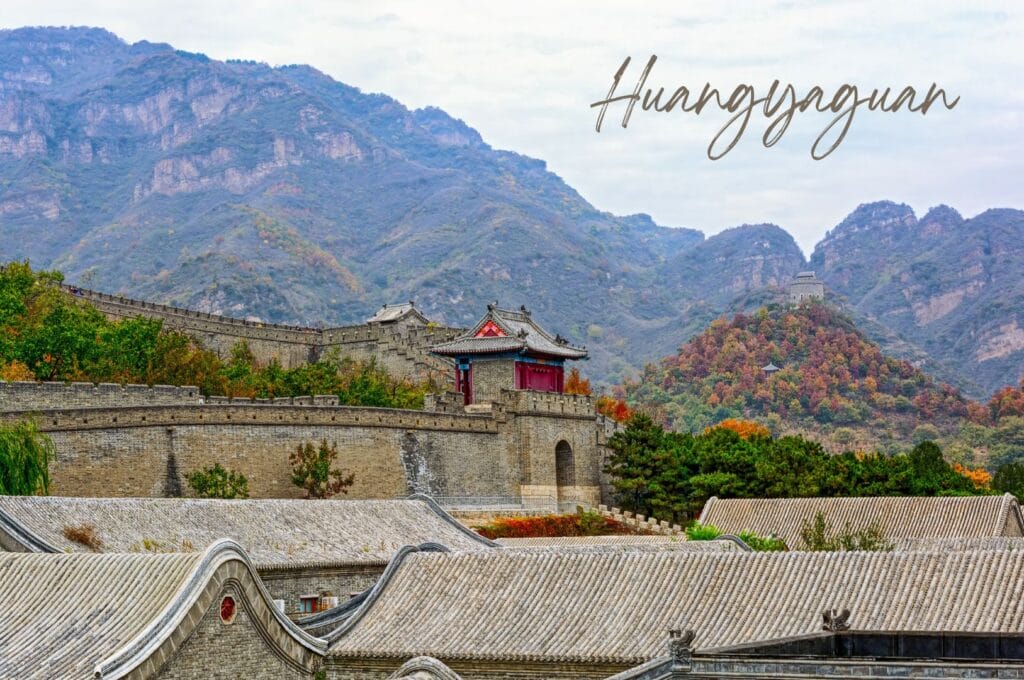
Introduction to Huangyaguan
Perhaps the name Huangyaguan (Huangya Pass) sounds familiar to you?! This is where the Great Wall of China marathon takes place in May, one of the most difficult in the world, with more than 5000 steps to climb! We assure you, you’ll have (a little) less to climb during your visit ;). But keep in mind that the terrain is very rugged and that good physical condition is necessary. Indeed, this portion of the Wall was also strategically important from a military standpoint, hence the presence of a fortress at the bottom of the valley.
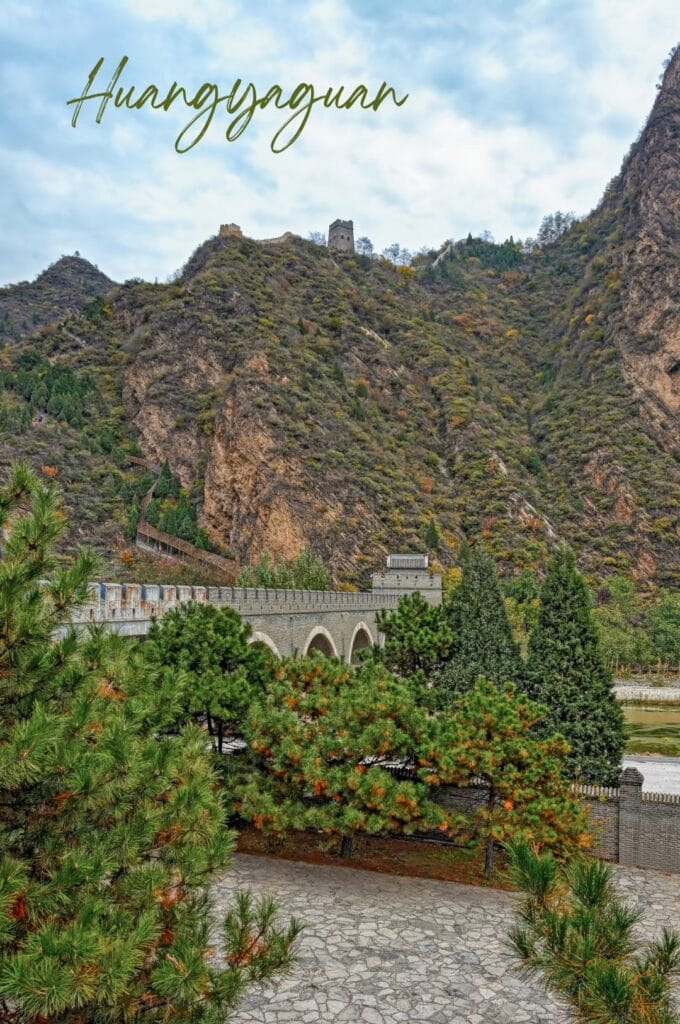
- a 4.5 km portion of the Great Wall of China built 1400 years ago during the Northern Qi dynasty and restored in the 1980s
- 20 watchtowers
- a maze
- few people
- a half-day visit
- 120 km from Beijing (3 hours by road)
Map of Huangyaguan
We found little information online about this sector and the trails… Here’s a fairly accurate map of Huangyaguan to help you find your way. We compared it with the satellite view and the Wall marathon route ;).
Visiting Huangyaguan
In total, this portion is a 9 km round trip with an elevation gain, given that the start is in the mountains, in the village of Taipingzhai. Then, the wall descends to the fortress of Huangyaguancun village to climb back up the other side of the valley to 680 m altitude. Also, you can just do the eastern part of the Wall by going to the fort where you’ll turn back. And as buses shuttle between Taipingzhai and Huangyaguancun, you can adapt the visit as you wish.
In any case, don’t miss strolling through the fortified city. You’ll see the Yin and Yang (Bagua) square and the amazing maze with its 8 trigrams. Then, climb back up to the west for 1 km and you’ll reach the steepest part of Huangyaguan, called Huangya Sky Ladder. Prepare your thighs! It’s from this point that the unrestored part of the Wall begins.
Note: If you have a private driver for the day, take the opportunity to discover the eastern Qing tombs and Dule temple (a Buddhist temple built in 984 that is the oldest wooden building in Asia).

Practical information
- Opening hours: The site is open from 8 a.m. to 5 p.m.
- How to get to Huangyaguan (3 hours from Beijing):
- With a tour: organized circuits are few. The only one worth it, in our opinion, is this one. In addition to going to the Huangyaguan Wall, you’ll visit the Eastern Qing tombs, the best-preserved mausoleum complex in China.
- On your own: from Beijing, there is no direct bus to Huangyaguan. You need to go to the Sihui bus station by taking subway line 1 (red-orange), Sihui stop. From there, a bus will take you in 2 hours to the Jizhou bus station (about 35 yuan for the ticket, departure every hour), east of Beijing. Then, you’ll have to get on the Ji Bus 3, which goes to Huangyaguan (1.5 hours of road, ticket price: 5 yuan).
- Staying in Huangyaguan: A few hotels are located at the foot of the Wall.
- Price: Entrance to the site costs 85 yuan per person. You can pay on site or book your tickets online.
Jiayuguan
Introduction to Jiayuguan
Jiayuguan is the western end of the Great Wall of China and clearly, it’s well-earned! Located almost 2000 km from Beijing, it is popular for its Xuanbi ramparts (which have a very different appearance from other sites) and also its impressive military fortress at the Jiayu Pass, on the famous and ancient Silk Road! It rises to 1700 m altitude and offers beautiful views of the Gobi Desert and the surrounding massifs. We recommend visiting if you’re taking a long trip across China. Otherwise, it’s quite a journey just to go all the way to the Western Wall ;). To go further, we recommend Silvia’s detailed article!
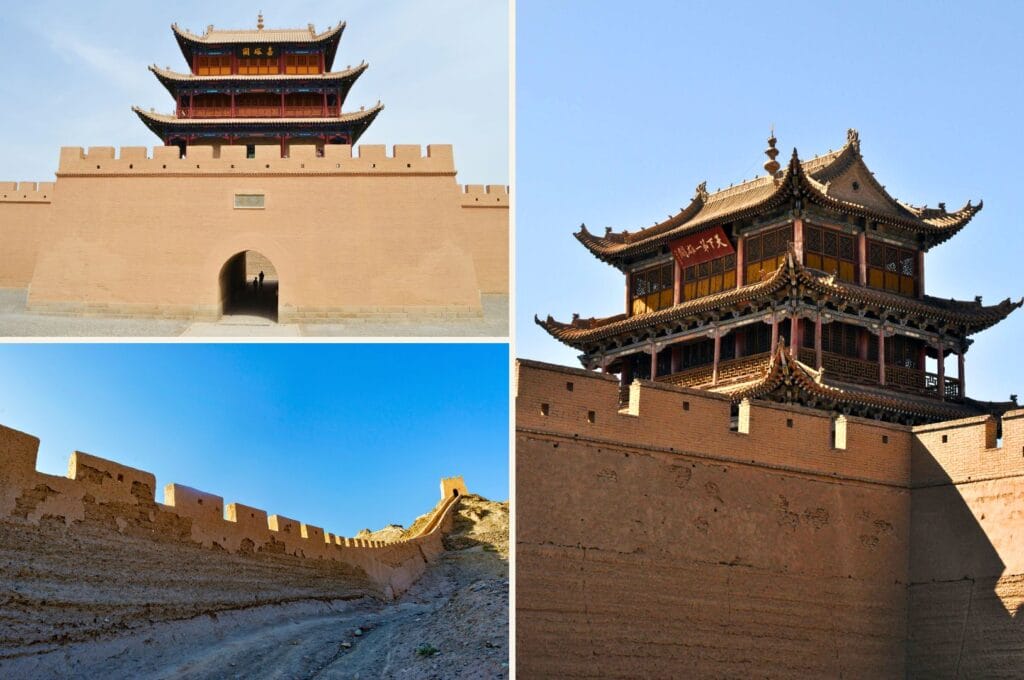
Practical information
- How to get to Jiayuguan:
- Staying in Jiayuguan: as it’s a big city, you’ll find plenty of hotels that will suit you.
- Price: Entrance to the site (fortress + Xuanbi Wall) costs 110 yuan per person.
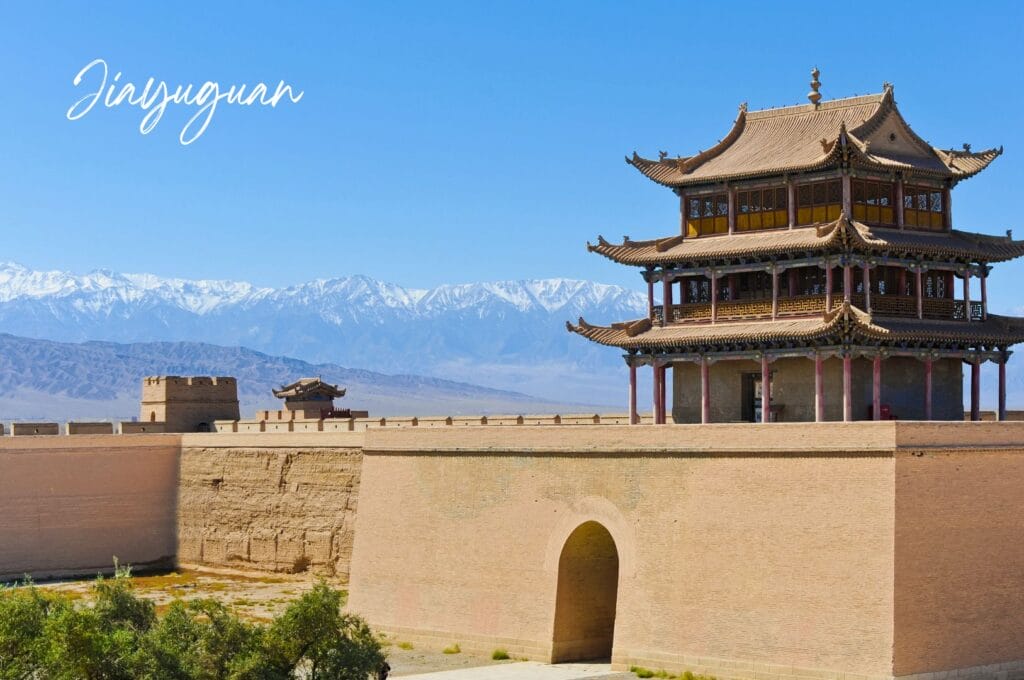
Final tips before visiting the Great Wall of China
- When to visit the Great Wall of China? Whatever happens, avoid the first 7 days of October! It’s the golden week, the week following the national day, and all Chinese citizens are on vacation. In short, any time of year except early October! To add to what we said about Beijing, prefer the period between March and October. If you can’t stand the heat, avoid the months of July and August and prefer spring. In autumn, the colors are magnificent!
- Prefer visiting during the week rather than the weekend and on Monday, you’ll be more peaceful. This advice is especially valid for the parts close to Beijing. Indeed, the Forbidden City in Beijing and other monuments in the capital are closed on Monday. As a result, travelers prefer the Wall. During the day, you’ll escape the crowds early in the morning (come at opening) or late in the afternoon, given that tours leave around noon or mid-afternoon.
- Keep your passport or ID card with you, it will be required in case of a check.
- Plan for food and plenty of water, whether you stay half a day, 1 day, or 2 days on the Great Wall of China. Yes, you’ll find everything in all sections (water, food, souvenirs…), but being a tourist area, everything is more expensive!
- It is, of course, forbidden to camp on the ramparts!
- Many travelers pass by the Wall during a layover of at least 9 hours in Beijing. If you meet all the conditions, you don’t need a visa and it still allows you to visit an incredible historical site on the Asian continent!
- Oh, and don’t forget your sunscreen; there’s no shade on the ramparts ;).

If you’re traveling to China and want to access Facebook, Instagram, YouTube, or even Google, know that these sites are blocked.
Therefore, you’ll need to use a VPN during your stay. On our side, we’ve had a subscription with ExpressVPN for several years and are delighted!
We hope this complete guide on the different sections of the Great Wall of China will help you prepare your visit! Leave us a comment if you have a question ;). For our part, after Beijing and the Wall, we’re off to visit Xi’an and its terracotta army!
P.S.: We’ve prepared a complete guide to help you prepare your trip to China (tips, itinerary, transportation…).
Pin it



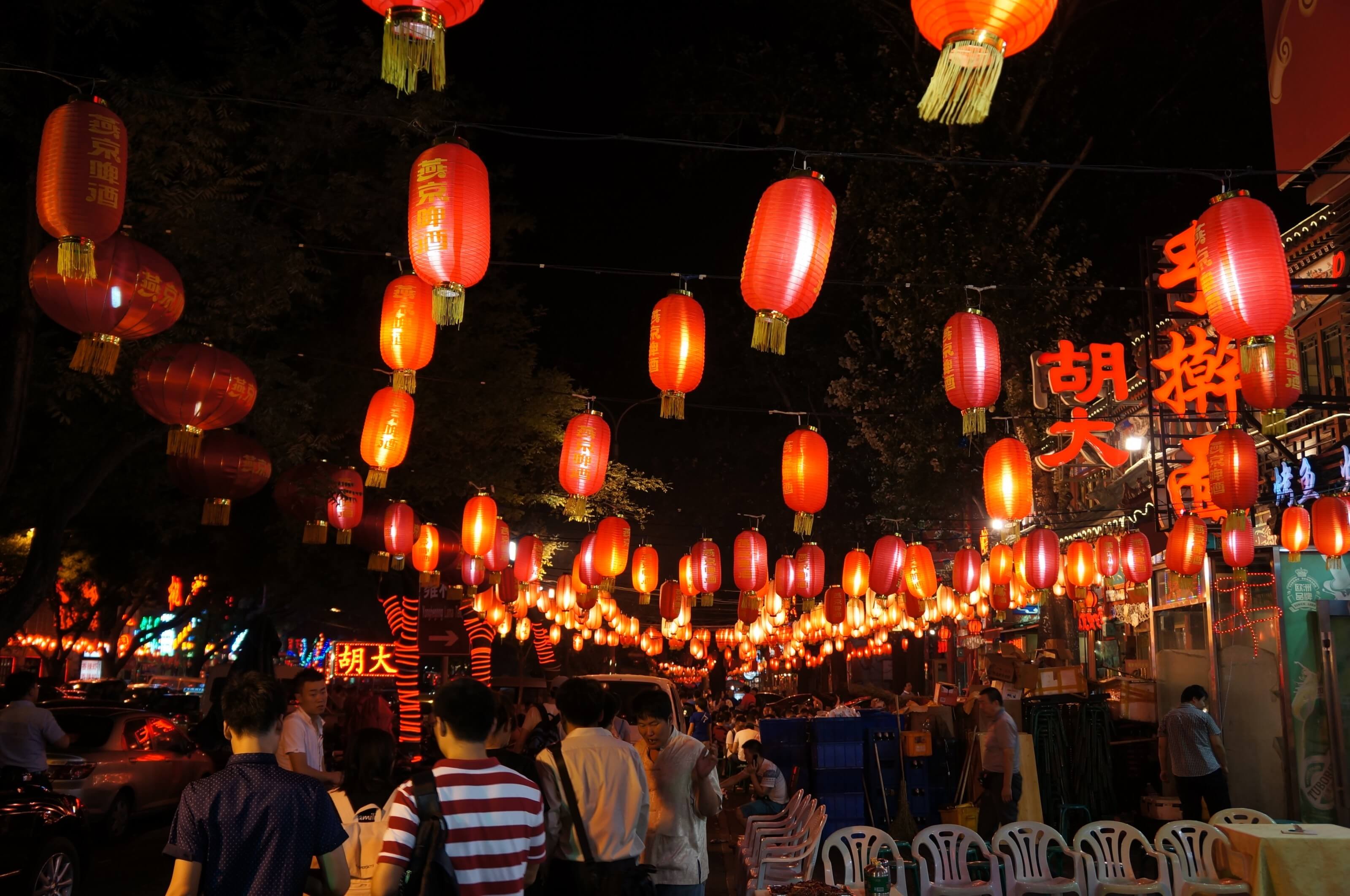
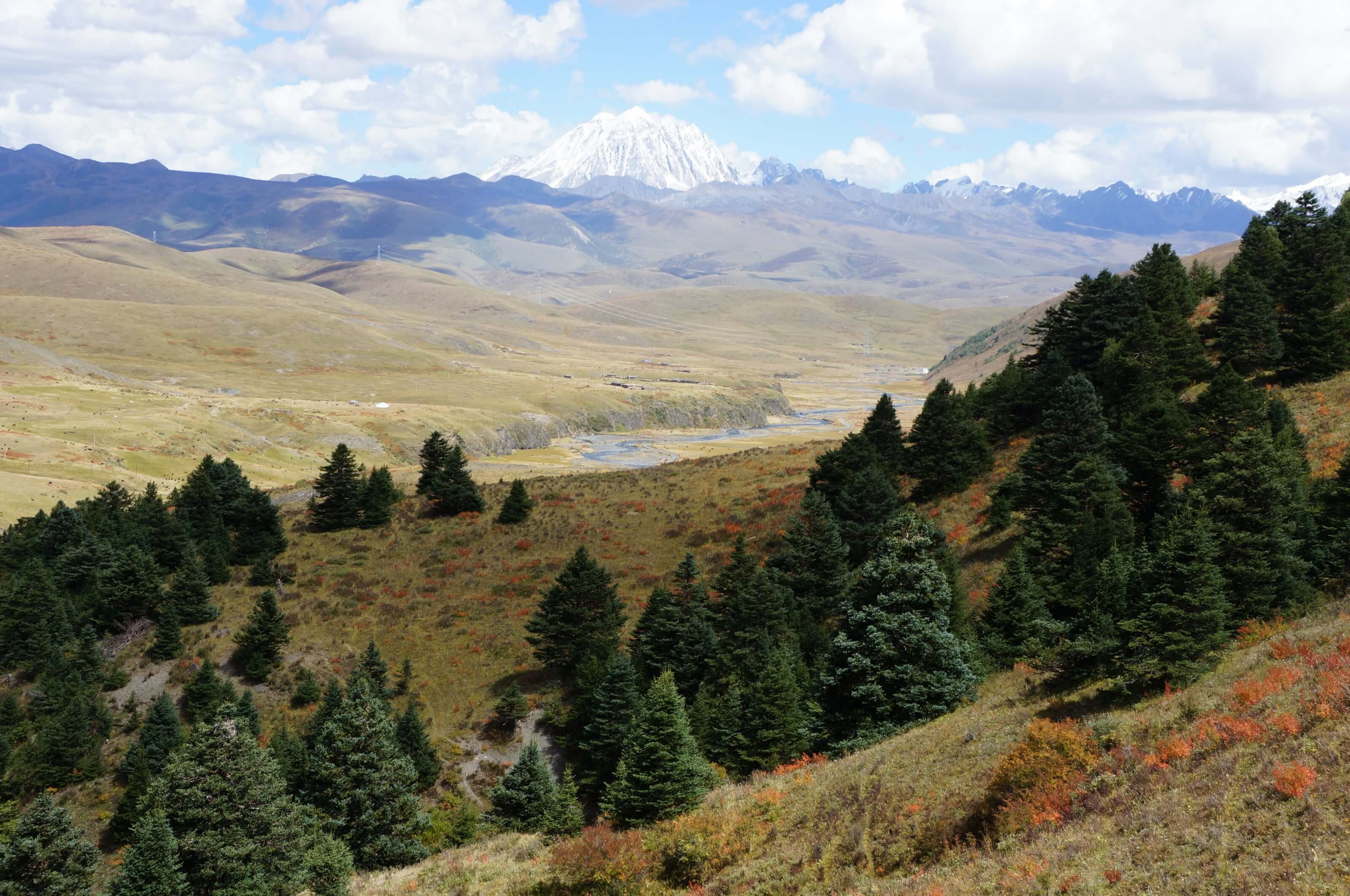

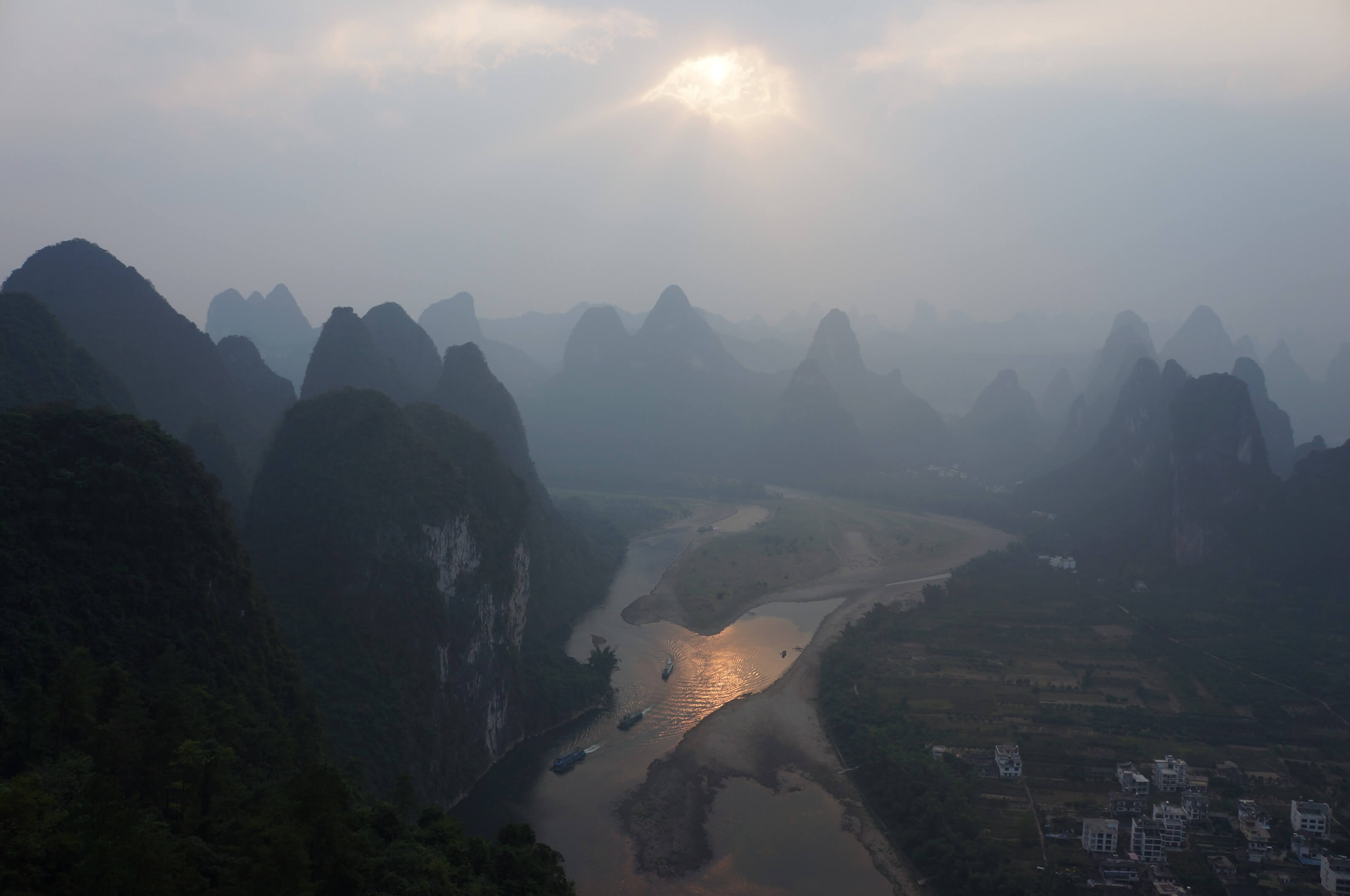
Hello Fabienne!!!,
I have just read about your Great wall of China adventures from ten years ago and am all in to walk the remote sections of the wall. I came across your website by accident and love the content you have put together.